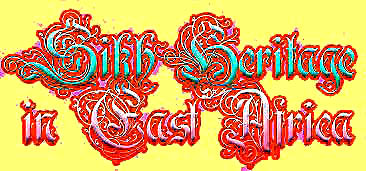

OUR FUNDEE OF THE FARM
From
Out of Africa by Karen Blixen (pp 333-5 392-4)
Pooran
Singh's little blacksmith's shop down by the mill was a miniature Hell on the
farm, with all the orthodox attributes of that place. It was built of corrugated
iron, and when the sun shone down upon the roof of it, and the flames of the furnace
rose inside it, the air itself, in and around the hut, was white-hot. All day
long, the place resounded with the deafening noise of the forge, iron on iron,
on iron once more, and the hut was filled with axes, and broken wheels, that made
it look like some ancient gruesome picture of a place of execution.
All the
same the blacksmith's shop had a great power of attraction, and when I went down
to watch Pooran Siugh at work I always found people in it and round it. Pooran
Singh worked at a superhuman pace, as if his life depended on getting the particular
job of work finished within the next five minutes.
He jumped straight up in the air over the forge, he shrieked out his orders to his two young Kikuyu assistants in a high bird's voice and behaved altogether like a man who is himself being burnt at the stake, or like some chafed over-devil at work.
But Pooran Singh was no devil, but a person of the meekest disposition;
out of working hours he had a little maidenly affectation of manner. He was our
Fundee of the farm, which means an artisan of all work, carpenter, saddler and
cabinet-maker as well as blacksmith; he constructed and built more than one wagon
for the farm, all on his own. But he liked the work of the forge best, and it
was a very fine, proud sight, to watch him tiring a wheel.
Pooran Singh, in
his appearance, was something of a fraud. When fully dressed, in his coat and
large folded white turban, he managed, with his big black beard, to look a portly,
ponderous man. But by the forge, bared to the waist, he was incredibly slight
and nimble, with the Indian hourglass torso. .
Pooran Singh was with me for
many years and was a well-paid functionary of the farm. There was no proportion
between his wages and his needs, for he was an ascetic of the first water. He
did not eat meat, he did not drink, or smoke, or gamble, and his old clothes were
worn to a thread. He sent his money over to India for the education of his children.
A small silent son of his, Delip Singh, once came over from Bombay on a visit
to his father. He had lost touch with the iron, the only metal that I saw about
him was a fountain pen in his pocket. The mythical qualities were not carried
on in the second generation.
But Pooran Singh himself raging above the forge,
kept his halo as long as he was on the farm, and I hope as long as he lived.
AND
HIS DEPARTURE
Some of my people now left the farm. As there was
to he no coffee and no coffee mill there any longer, Pooran Singh found himself
out of work. He did not want to take on another job in Africa, and in the end
he made up his mind to go back to India.
Pooran Singh, who mastered the minerals,
outside of his workshop was like a child. He could not in the least realise that
the end of the farm had come; he grieved over it, wept clear tears that ran down
in his black beard, and for a long time worried me with his attempts to make me
remain on the farm, and with his plans for keeping it going. He had taken much
pride in our machinery, such as it was, and was now for a while as if nailed to
the steam engine and the coffee-dryer in the factory, his soft dark eyes consuming
every nut in them. Then, when in the end he had been convinced of the hopelessness
of the situation, he gave it all up in one movement, he was still very sad, but
quite passive, and sometimes when I saw him he talked much of his travelling plans.
When he went away, he carried no luggage with him but a small box of tools and
soldering outfit, as if he had already sent his heart and life over the ocean,
and there was now only his thin, unassuming, brown person and the soldering pan
to follow it.
I wanted to give Pooran Singh a present before he left, and
I had hoped that might have something in my possession, which he would like, but
when I spoke to him of it he at once with great joy declared that he wanted a
ring. I had no ring, no money to buy him one . . . . Before Pooran Singh left
I had, however, raised enough money by the sale of my furniture to buy him the
ring he wanted in Nairobi. It was of heavy gold with a big red stone, that looked
like glass. Pooran Singh was happy about it that he shed a few tears again, and
I believe that the ring helped him over his final parting with his machinery.
For his last week, he wore it every day, whenever he came to the house, he held
up his hand, and showed it to me with
a radiant, gentle smile. At Nairobi
station, the last thing that I saw of him was this slim
dark hand, that had
worked on the forge with such furious speed. It was stretched through the window
of the crowded and overheated Native railway carriage, in which Pooran Siugh had
placed himself upon his tool-box, and the red stone in it shone like a little
star while it went up and down, waving good-bye.
Pooran Singh went to the
Punjab to his family. He had not seen them for many but they had kept in touch
with him by sending him photographs of themselves, he preserved in his little
corrugated iron house by the factory, and showed to me with great tenderness and
pride. I had several letters from Pooran Singh already from the boat to India.
They all began in the same way: 'Dear Madam. Good-bye.' And then went on to give
me his news and to report on his adventures of the journey.
BUILDING SIXTY-FOUR
From interview with Harjit Singh Ranauta, Eldoret
My
grandfather Prem Singh Ranauta first came to Kenya when he was 27 years old. Unlike
the vast majority of immigrants from India he was not a penniless young man. The
family had (and still has) a workshop in Ludhiana, where blacksmithing and carpentering
were done. But somehow my grandfather got into the recruiting business. He was
encouraged by the British to take people to Kenya. He did most of his recruiting
in Ludhiana, amongst his fellow Sikhs and most were his relatives. He made his
first voyage in 1917, bringing with him about a dozen people. Then he went back
to India, recruited some more people and came to Kenya again. He usually brought
over a group of people 10 to 15 men every six months. They came by dhows, those
old-fashioned ships with sails. The recruits were given free passage and free
food as well.
When he brought people over he lodged and fed them until he
was able to place
them, in the police, in the military, in the PWD, wherever
they were required. Some of them went to Mombasa, Nairobi and Kitale, but many
stayed here in Eldoret, which was then called 'Sixty- Four'. My grandfather
particularly liked this place. In 1922 he brought over his wife Prem Kaur and
their children. (My father Dasounda, - born in 1906, was the eldest of their three
sons and three daughters.) At first the family and the recruits had to stay in
c.i. sheet huts, but then in 1926 my grandfather built a big house that served
as a hostel as well. It was a fine building, with a verandah with pillars out
front, right on the main street that was being allocated to the Indians for building
their places of worship. It also served as the original Sikh temple, for my grandfather
put aside one room to serve as the gurdwara, and it remained as such in our family
home.
Then my grandfather stopped recruiting and settled down in Eldoret
to work at building full-time. There was so much work that people continued to
come even without his going over to India to fetch them. And having so many people
at his disposal enabled him to undertake a tremendous amount of work.
My grandfather
was the only contractor in the town. He'd been building the Indian Bazaar, all
the c.i. sheet buildings along the Uganda Road. Around 1926 he built the mill
for 'Unga Ltd.' and he started in on the Indian places of worship. He built
the Ramgarhia Sikh Temple, just across the road from his house. Then he the Hindu
Temple (the original building that is still standing), the Patel Brotherhood Hall,
the Ismaili Jamatkhana and the Muslim Mosque.
In 1934 my grandfather started
the Kiplesso Sawmill' in Timboroa, a place high up in the forest 45 miles from
here. He built a house there, a big wooden house with a fireplace, and with a
garden. He kept his own horses there and he and myfather used to ride from Timboroa
up to here on the horses, brown ones. I remember seeing them when I was a child.
It was only in 1942 that my grandfather bought the first car, a Model A Ford.
My father got married to Nand Kaur and they had a big family, three sons and four
daughters, every one born in Eldoret. Myself I was born in 1939. I remember quite
a lot about my grandfather because he lived until 1954. He liked to talk to us
youngsters about the old days. He was still strong and clear-minded when he died,
and my father, who died just 3 years ago, in 1987 at the age of 81, was also like
that.


Kiu Station in early days with Indian firemen (Kenya Railways)
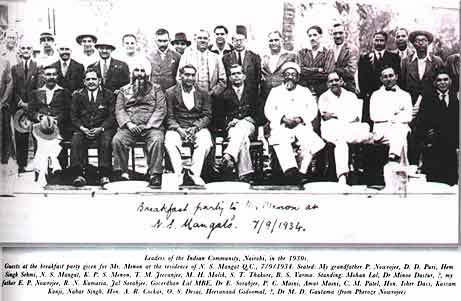
Nahar Singh Mangat QC was a very prominent Sikh Lawyer and member of Legislative Council. He is seen with prominent members of the Indian Community with Krishna Menon, later on the Defence Minister of India after Independence in 1947. Sr. Hem Singh Sehmi, a popular building contractor, is also seen in the photo (turbanned) A very remarkable photo.
A GRAVE
SITUATION
From K.A.R. by W. Lloyd-]ones- p 60-65 passim
To cope with this grave situation [the Uganda Mutiny] Macdonald and Jackson had but a force of ten Europeans, seventeen Sikhs, two Maxims and some 350 armed Swahili porters who were, however, no match for the stalwart Sudanese soldiery.
Reinforcements of Indian troops had at last made their long-awaited appearance, and a detachment of 150 sepoys, under Lieutenant Scott, was ordered at once to proceed down the Nile to prevent, if possible, any communication between the mutineers and the doubtfully loyal Sudanese garrisons in Unyoro….
THE GALLANT SIKH
From Early Days in East Africa by
F.Jackson (pp 306, 310)
I paid my [Sudanese] men the arrears, but they
were told that they must accompany
Macdonald on this expedition and that their
other grievances would be attended
to on their return. They then broke into
open revolt, refused to give in their arms
when ordered and marched off on
the road back to Uganda. . . . [This was in October
1897]
We followed
them up with the Swahili askaris who were available and some dozen and half Sikh
soldiers. .
[I was] an unwilling and helpless witness of what was little less
than a deliberate murder, but perhaps justifiable under the circumstances. What
I saw was this. A splendid great Sikh with a shattered arm was being supported
and led away by two of his comrades, while two others were holding and trying
to restrain another, mad with rage, who was making furious lunges with his fixed
bayonet at Macdonald's Swahili boy. The wretched boy, equally crazy with terror,
was being held by two other Sikhs, who, to their credit, were doing their utmost
to keep him out of reach of the bayonet, when the infuriated Sikh gave another
ineffectual lunge, and at the same time pulled the trigger, whereupon the boy
dropped down dead. It appeared that the boy, who was carrying his master's Express
rifle, was overcome with excitement, and Swahili-like simply pushed it forward
without raising it to the shoulder, and pulled the trigger in the hope that he
would hit a mutineer, instead of which he nearly blew off the arm of the Sikh
serving the belt of the Maxim, and just in front of him.
That gallant Sikh,
after months of torture through declining to submit to amputation, made a good
recovery, though his arm was quite useless, and he was one of the eighty wounded
or time-expired men I took to the coast eleven months later.
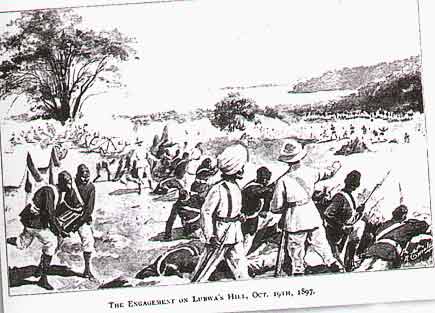

THE
ASTROLOGER & THE SAINT
From interview's with Tarawati
Sofat, Nairobi
Yes, this is a photograph of Babaji. That's how we called him, 'Honoured Father'. His proper name was Puran Singh. He lived in Kericho where he had a furniture-making business. How did we meet? My late husband Baburam Sofat, who had come to Kenya when he was fifteen, worked in the Labour Department for 40 years! He would go to Kisumu and Kericho to give out pay. He met Puran Singh in Kericho and by 1942 they were fast friends. No, my husband was not a Sikh like myself, he was a Hindu Punjabi. He was an astrologer and palmist, so he was known as Jyotshiji. He had very many people coming to him. Even many Europeans. They were crazy about him. He'd be busy from morning until 6 pm. He didn't charge when he started. He wrote to his guru (in India) about this. The guru, Swami somebody, allowed him to charge 20/-. When my husband first met Babaji, he said to him, 'I want to read your hand.' When he saw Babaji's hand lines he said, 'You are a saint.' But nobody' else knew it.
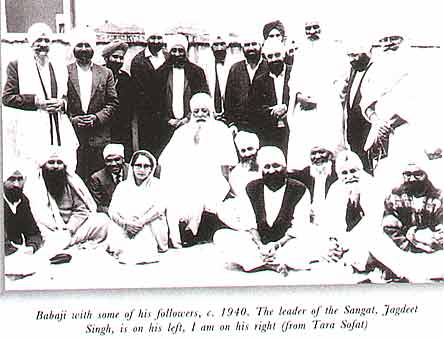
When my husband first met him, Babaji was living quietly in
Kericho. I don't
know anything of his background, but here is the "Sikh
Sandesh" published in London
(11/8/83) after his death which tells all
about him. It's written in our language Gurumukhi
but I can translate it
for you. It says that Babaji was born in the Punjab in 1898, that he left school
when he was twelve to work as a carpenter. Then in 1916 he and his elder brother
Isher Singh, with whom he'd been working, came to Kenya. He worked in Eldoret
for five years and in Kitale for four. In 1930 he started his own business in
Kericho, making furniture. He brought his family over (he had two sons and four
daughters).
This article says he had been very religious since he was a young
boy. Although he worked hard in his business, his main interest was praying. He
employed many people in his workshop and he would go around and supervise them,
then sit in a corner and meditate. He'd make the rounds again, then go back and
meditate. He and my husband had so much in common. My husband could sit three
for four hours in prayer.
When Sofatji went to Kericho he'd stay with Babaji
and they'd talk about religion and things. But Babaji didn't talk like that with
other people, he never tried to attract people to him. At first nobody knew be
was a holy man. He looked like other people, wearing a suit for business, although
at home he put on white pyjamas and a white shawl. He always kept his beard loose
(and encouraged his Sikh followers to do likewise). He had amazing powers. One
time my husband went to Kericho with Babaji. They stopped at Naivasha
by a
big rock to eat the lunch they had carried with them. Suddenly my husband noticed
a lion coming very close. Babaji spoke to the lion. 'Do you want to share our
lunch?' He put some food on the ground. The lion came and took it and walked away.
Sofatji, he was shaking he was so afraid, couldn't believe it.
They continued
their trip. It was during the rainy season. A large tree had fallen across the
road, a huge tree. The tree was shaking. Babaji went in to it, amongst the branches.
The tree shifted so there was room to drive past. Sofatji said he could hardly
believe his eyes.
At that time Babaji still was unknown. When he came to Nairobi,
he never stayed with his own relatives because they ate meat and drank. Mainly
he stayed with Jaswant Singh in the Railway quarters, but he'd also spent a day
or two with us. When we built this house (in South B) Babaji laid the foundation
himself. Every time he came he gave us light. You couldn't see the light but you
felt it.
In 1941 Babaji came to our house. He didn't know I was expecting,
and that I was scared because I thought something was wrong. (No, it wasn't my
first pregnancy, it was my third.) He said, is something troubling you? Don't
worry.' And he blessed me, saying 'God is great. You must pray all the time. He
will look after you.' He explained that God looks after us, just the way we hold
a cup that is cracked so it won't fall apart. He always spoke slowly and with
just a few words, and then left you to think about what he had said.
My baby
girl was born all right. But after sixteen days I became ill, and I was three
months in bed. In 1941 there were no clever doctors here, no good medicines. The
doctor wanted to put me under anaesthetic. Then Babaji came. 'Don't worry,' he
said as he blessed me. And I got better without any operation.
Slowly
people came to know he was a holy man. They talked about him and his reputation
spread. We started having meetings in the South C gurdwara when he was here, so
people could see him, have darshan. When Babaji realised he was known he made
a society. Jagjeet Singh was the leader of our sangat. Babaji gave us all holy
water [the Sikh initiation. About 100 of us went, the ceremony was held in the
South C Gurdwara. That was about 30 years ago.
We would meet twice a week
for prayers. Once every six months or so we would all go up to Kericho for an
'Akand Path', three-day continual prayers. Big crowds would gather at Babaji's.
He would clear out his workshop and we would have the meeting there, with prayers
and singing. No one asked why you came, you were just made welcome. Everything
was ready, food and bedding for everyone. Babaji's wife was helping. Baiji looked
after him very well, his clothes and his food. She was a simple woman, very good
hearted. She loved people, both grown-ups and children.
Babaji would sit there,
talking with the people up until 11 pm. He'd be laughing and chatting. He wasn't
a serious man. When you met Babaji you felt very fresh. He'd give you a great
look, a great smile. Even one word from him made you feel good. He gave us his
light.
I think Babaji had a gift from God. God gives different gifts. (He
gave me the gift of singing nicely.) Babaji had the gift of healing, of making
people feel better.
According to this article he first realised he had some
power when he was very young, when he cured his father of a terrible pain in his
neck. But he never demonstrated his powers publicly, only when you went to him.
Or he would come to you. You would how and touch his feet out of respect and he
in turn would put his hands on you as a blessing, a healing.
Around 1970 Babaji
went to live with his son in London. The other son died but his son Billy still
lives in Kericho. Yes, that was the one you met, his real name is Ragbeer. I'm
not surprised he was not helpful, neither of the sons ever followed their father.
But many, many other people did. He got to have a huge following in UK.
About
ten years ago (May 29th 1983) Babaji had a heart attack. He said that it came
from God and he accepted it. His son wanted him to go to hospital. Babaji said,
This is my last day. If I go to hospital I don't come back.' His son insisted
-and after two or three hours Babaji was gone. But before he passed away he gave
his spirit to his disciple Naurang Singh
Now look at this photograph of his
funeral. You can see the huge crowd proceeding with the coffin. The article says
that there were 35,000 people present for the cremation. And as you can see, "Sikh
Sandesh" published this special issue, the Sant Baba Puran Singh Edition',
to commemorate his death. It is all about Babaji, nothing else.
Here we are
not so many now. My husband Sofatji passed away in 1989.Jagjeet Singh, the leader
of the saugat here, has also died. Babaji's followers have dispersed. We no longer
have meetings at the gurdwara. Those of us who believe in him, we pray at home.
He still gives us his light.
I first heard about Baba Sant Puran Singh Kerichowalla, Kenya's home-grown Sikh saint, in Kericho. I tried to interview his grandson there but Ragbeer was clearly disinterested in his venerable grandfather. It wasn't until several years later that a chance query to Mrs. Sofats's brother Trilok Nayar [see "Why I Feel So Sad"] put me in touch with some of Babaji's still devoted followers in Nairobi. Meanwhile, randomly perusing old issues of the "Standard", I had come across a small item about a fortune-teller. It turned out to be part of the same story.(Cynthia Salvadore)
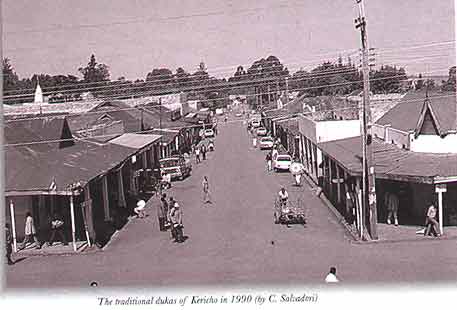
Kericho, the town made popular by the holy Baba Puran Singh Ji
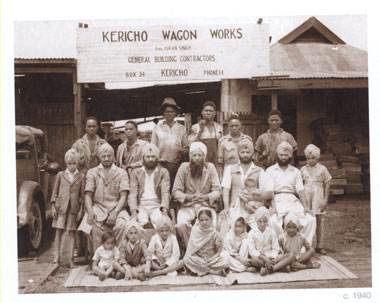
Kericho Wagon Works of Sant Puran Singh Ji in Kericho
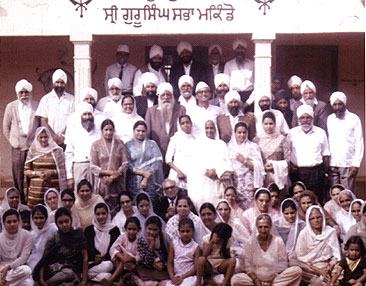
Sant Puran Singh Ji with sangat at the Makindu gurdwara
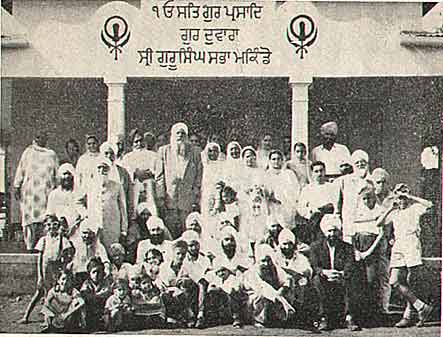
Baba Puran Singh Ji with Sangat members at the Gurdwara Makindu on Mombasa Road. The Sikhs had built a small place for worship, which was 100 miles from Nairobi and 200 miles from Mombasa (port), during the building of the railways. Legend has it that an African who took care of the place, used to see a Sikh horseman in beautiful attire, get off the horse and pay obeisance on the steps of the Gurdwara. He saw this horseman quite a few times and told the Sikhs about it. From his description it was deduced that it could be no one other than Guru Gobind Singh. This legend is well known till this day. This Gurdwara, middle of nowhere, is visited by thousands of people of all castes and creed everyday going to and fro Nairobi and Mombasa. Langar is available 24 hours a day and the place looks like a 3 star hotel now-a-days, with rooms to stay the nights. Simply a masterpiece and a feather in the turban of the Sikhs.
Baba Ji was one of the first persons to come to this Gurdwara regularly and perform keertan and paths and eventually it caught on and now this Gurdawara can be classified amongst the top gurdwaras of the World - income and visitation vise.
MAN OF MYSTERY
From West with the Night by
Beryl Markham (pp 61-66 passim)
As I scampered past the square hay shed
a hundred yards or so behind the Elkington house, I caught sight of Bishon Singh
whom my father had sent ahead to tend our horses.
I think the Sikh must have
been less than forty years old then, but his face was never any indication of
his age. On some days he looked thirty and on others he looked fifty, depending
on the weather, the time of day, his mood, or the tilt of his turban. If he had
ever disengaged his beard from his hair and shaved the one and clipped the other,
he might have astonished us all by looking like one of Kipling's elephant boys,
but he never did either, and so, to me at least, he remained a man of mystery,
without age or youth, but burdened with experience, like the wandering Jew.
He raised his arm and greeted me in Swahili as I ran through the Elkington farmyard
and out toward the open country. .
I was within twenty yards of the Elkington
lion before I saw him…What I remember most clearly of the moment that followed
are three things -- a scream that was barely a whisper, a blow that struck me
to the ground, and, as I buried my face in my arms and felt Paddy's teeth close
on the flesh of my leg, a fantastically bobbing turban, that was Bishon Singh's
turban, appearing over the edge of the hill.
It happened like this - as Bishon
Singh told it;
'I am resting against the walls of the place where hay is kept
and first the large lion and then you, Beru, pass me going toward the open field,
and a thought comes to me that a lion and a young girl are strange company, so
I follow. I follow to the place where the hill that goes up becomes the hill that
goes down, and where it goes down deepest I see that you are running without much
thought in your head and the lion is running behind you with many thoughts in
his head, and I scream for everybody to come very fast.
'Everybody comes very
fast, but the large lion is faster than anybody, and he jumps on your back and
I see you scream but I hear no scream. I only hear the lion, and I begin to run
with everybody, and this includes Bwana Elkington, who is saying a great many
words I do not know and is carrying a long kiboko (whip) which he holds in his
hand and is meant for beating the large lion.
Ewana Elkington goes past me
the way a man with lighter legs and fewer inches around his stomach might go past
me, and he is waving the long kiboko so that it whistles over all of our heads
like a very sharp wind, but when we get close to the lion it comes to my mind
that that lion is not of the mood to accept a kiboko.
'He is standing with
the front of himself on your back, Beru, and you are bleeding in three or five
places, and he is roaring. I do not believe Bwana Elkington could have thought
that that lion was not looking the way he had ever looked before when it was necessary
for him to be beaten . He was looking as if he did not wish to be disturbed by
a kiboko, or the Bwana, or the syces, or Bishon Singh, and he was saying so in
a very large voice.
'I believe that Ewana Elkington understood his voice when
he was still more than several feet from the lion, and I believe the Bwana considered
in his mind that it would be the best thing not to beat the lion just then, but
the Bwana when he runs very fast is like the trunk of a great baobab tree rolling
down the slope, and it seems that because of this it was not possible for him
to explain the thought of his mind much closer to the lion than in his heart he
wished to be.
'And it was this circumstance, as I am telling it,' said Bishon
Singh, 'which in my considered opinion made it possible for you to be alive, Beru.'
'The lion, as of the contrary, rushed at Bwana Elkington,' said Bishon Singh.
'The lion deserted you for the Bwana, Beru. The lion was of the opinion that his
master was not in any honest way deserving of what he, the lion, has accomplished
in the matter of fresh meat through no effort by anybody except himself.'
Bishon Singh offered this extremely reasonable interpretation with impressive
gravity, as if he were expounding the Case For The Lion to be chosen jury of Paddy's
peers
'The lion rushed for Bwana Elkington, who in his turn rushed from the
lion, and in so rushing did he keep in his hand the long kiboko, but allowed it
to fall upon the ground, and in accomplishing this the Bwana was free to ascend
a very fortunate tree, which he did.'
'And you picked me up, Bishon Singh?'
He made a little dip with his massive turban. 'I was happy with the duty of carrying
you back to this very bed, Beru, and of advising your father, who had gone to
observe some of Bwana Elkington's horses, that you had been moderately eaten by
the large lion. Your father returned very fast, and Bwana Elkington some time
later returned very fast, but the large lion has not returned at all.'

INNOCENT
PRISONER OF TSAVO
From Innocent Prisoner of Tsavo (ms) by Lalchand
Sharma (pp 31-32)
We were escorted by British soldiers and taken to
the Fort Jesus Jail at Mombasa. The Sergeant-Major from Bharatpur State handed
over an envelope to Colonel Vicor who opened it at once. After reading it, he
informed us that we had been brought down for hanging. Before we were locked up,
the Base Commanding Officer sepa-rately told Bishen Singh that he shall be hanged
the next morning. Sardar Bishen Singh, a Jat by caste, was from one of the 'basties'
(shanty-towns) of Jullundar City, Punjab, and he was a junior partner of Rama
Nand, Bodh Raj & Co. He held a one-fourth share.
Our cells were six feet
by three feet. The doors had iron bars on the top and at the bottom, through which
one could see outside by standing up and by lying down. A small toilet bucket
was kept in each cell. A dirty blanket, full of lice, was all that passed for
our bedding. These cells were meant for the condemned and they were near the main
prison gate.
Early next morning, eight English soldiers came into the Prison
and took Sardar Bishen Singh with them. He was hanged near the Old Mombasa Market,
in front of the general public. He, too, was an innocent person, another victim
of the hatred the British farmers settled in Kenya bore towards the Indians
for demanding equal rights.
MEMORIAL
& MURDER
Contributed by Hassanali H. S. Verjee, Mombasa
from his, 'A Family History" (ms)
When my father Hussein was the
Chairman of the Indian Congress he engaged as secretary M. A. Desai who was his
loyal, efficient and astute colleague for many years. Desai regularly had lunch
with my father and they were always talking politics.
Desai, a bachelor, was
a very straightforward, outspoken person. His fluent English proved an invaluable
asset when dealing with political issues (my father spoke little English). My
father gave him a generous allowance during his lifetime, and when Desai died
[in 1926J Hussein organised a door-to-door collection to build the Desai Memorial
Hall.
My father's next secretary in the Indian Association was a recent arrival
from London. Isher Dass, who had originally been recruited by A.M. Jeevanjee to
market radios in the colony. This venture was not a success but my father bought
a radio from Mr Dass and in the ensuing conversation recognised his talents (he
had been political activist in London), and so offered him this important post.
Isher Dass La Hindu Punjabi ] had an Anglo-Jewish wife in a period when cross-cultural
marriages were extremely rare. Consequently, she was ostracised by the arrogant
European community in Kenya. Out of sympathy, my father engaged her as a typist
on a monthly salary Shs.1000/- although he did not really require her services.
After my father died, Isher Dass came to me and said he wanted a photograph of
my father to put in the Desai Memorial Hall. That was such a petty way of showing
gratitude. I said, 'What do you take me for?'
Isher Dass was a very talkative
person, the kind of person who you hear at Hyde Park. He was a very fluent speaker,
especially in Hindustani. He was the biggest mischief- monger in this country.
It was he who divided Muslim and Hindu. My father and -I agree - was totally against
the Indians in East Africa dividing themselves into Muslims and Hindus. Many years
later, Isher Dass became the secretary of an organisation recruiting young Asians
for the British Army to serve in the Second World War.
[He was appointed Deputy
Director of Asian Power] This post provoked antagonism amongst some sections of
the community and [in November 19421 he was murdered by a group of Sikhs. He was
shot in his office in Desai Hall.
He started his political career as a champion of the underdog and died of its bite. At the outset his popularity with the masses was remarkable; at the end, his unpopularity pathetic. . . During his lifetime, Isher Dass could draw huge crowds at his political meetings. The same crowds gathered in larger numbers to mourn his murderers and acclaim them as heroes. (from "In Memoriam; Who Was who" by S. Pandit)
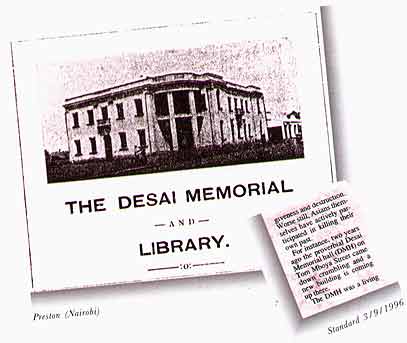
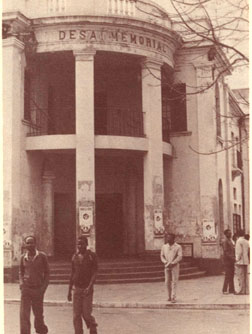
Desai Memorial Library - a landmark
A GIFT FROM AN INDIAN TO A SOUTH AFRICAN
From interview with late Indar Singh Gill, Nairobi (see also part one)
I had started the
Sikh Sawmill in Jinja. One day I was driving from Jinja to Nairobi. As I passed
the Forest Department near Timboroa area I saw the sign for the 'Burnt Forest
Sawmill'. I stopped.
The owner came up and said, very unfriendly, 'What do
you want here?' I explained that I had sawmills in Uganda and wanted to have a
look around his, just to compare notes. He was a South African, Bobby Ball by
name, and he was not willing to show me around. So I said I'd buy his sawmill,
what did he want for it?
He thought a minute and then said, 'Shs. 400,000/-',
for everything except his personal effects, assuming of course that I couldn't
possibly afford such a high price. "Fine", I said, "only I don't
have my chequebook with me. Could you give me a leaf of yours?" He looked
startled. 'Which bank,' he asked. 'Any,' I said, 'Barclays, Standard, whatever
you have. I have accounts in them all.' He gave me a leaf from his chequebook
I wrote him out a cheque for the sum he'd asked.
Now, he had several horses
at the mill. I left him with a couple but as I used to like to ride (my father
had horses on the farm in India) I took three or four for myself, took them to
Jinja. We agreed that saddles were personal property so he charged me for the
saddles. That was fair. Those people were very good to do business with, those
hard-headed Settlers.
Then Mr. ball said he wanted some timber and some nails,
to build himself a new house. He offered to pay, 'You charge me,' he said. 'No',
I said, 'This will be a gift from an Indian to a South African.'
(South Africa in those days was the home of apartheid and the attitude of South Africans towards all black and Asian people was very vulger as can be seen from the above. But S. Inder Singh Gill put the South African in his shoes by offering to buy him off -[Kanwal])
The following is a letter showing the participation of the Asian Cricket in the East African Sports circle, which was dominated by Europeans.(Kanwal)
INVITATION
TO PLAY
From "Asian Sports Association, Souvenir Magazine"
The
initiative for holding the first representative cricket match between the Euro-peans
and Asians which has long since become the outstanding annual sports event of
Kenya did not come from the sports organisation of either community, but from
E.P. Nowrojee, one of the best cricketers of his day, who captained the Asian
team a number of times. {E.P. Nowrojee was lawyer by profession.)
.....................................................................................................................................
Law Courts
Nairobi 11th October, 1932
The Secretary,
Kenya Kongoni Cricket Club
Nairobi
Sir,
Re: Asiatic
Cricket
The Asiatics in this country fed aggrieved at not being allowed
to participate in the Country Cup matches. In the Cricket Season 1927-1928, when
the Railway Indian Institute was at its zemith, the Institute voiced this grievance
but met with rebuffs. The result was that Asiatic cricket has never had official
recognition in this country. In spite of this drawback you will perhaps have noticed
the vast interest in outdoor sports which the Asiatics have evinced. There are
as many as eight cricket clubs in Nairobi alone. Mombasa, Nakuru and Kisumu are
not far behind.
Now the Kongonis have become the governing body of cricket
in this country, the Asiatics feel that though they be banned from participating
in the Country Cup matches, they may be given some recognition and encouragement
in cricket circles.
An annual International fixture of a three-day match
between Europeans and Asiatics of the Country meets with the approval of various
members of Asiatic clubs whom I have approached in this matter. I have even been
promised a floating trophy if it is acceptable to your Committee.
I have not
approached any member of the European Community with regard to this proposal but
I feel sure that it will not be put down, without proper consideration having
been given to it by yourself and your committee.
Yours faithfully,
E.P. Nowrojee

This cricket team boasted 3 Sikh players. Two brothers Jaswant Singh and Gurcharan Singh were the owners of "Photo Studio"in Government Road, Nairobi. These two brothers were very prominent members of the Sikh Union Club.
"ASIAN SPORTS IN EAST AFRICA"
A BRIEF HISTORY
OF THE
SIKH UNION
(Now SIMBA Union)
NAIROBI
Traditions which are not valued, which are not guarded, which are not expounded afresh to every generation as in its turn it steps on to the arena of the centuries, those traditions will grow weak and pass. Therefore there is a real need and a real justification for the work of such a society as the Sikh Union, which sets itself to guard, invigorate and transmit the traditions of Sikhs.
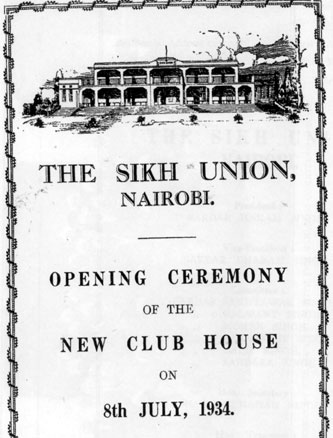
The Sikhs are known as a martial race all over 4he world. Their deeds of bravery, acts of self denial, spirit of comradeship and generous treatment of friends and foes alike, are proverbial.
Wherever they go, they carry their traditions with them, and jealously guard them. Having such a rich legacy from their ancestors, it was quite natural for the Sikh pioneers of this Colony to decide upon an easy and practicable way by which to preserve the fine trails of their race. Religious Institutions had their first attention, lint, in course of lime, the necessity for aSports Institution was keenly felt, and during the year 1920 the Khalsa Club was formed. It started with football as the only game, but with Hi-influx of further players, hockey thrived,, and continued to dominate other sections of sports subsequently introduced by the Club.
During the latter part of 1926, the Khalsa Club was renamed the " SIKH UNION;" rules and regulations governing the Constitution were drafted, and the Institution was put on a definite and permanent basis. The objects of the Union are to provide for the social, intellectual and physical improvement of its members. The Entrance fee was fixed at Shs. 10/- and the monthly subscription at Shs. 3/-. Resulting from this re-organisation, the success achieved during the year following and the hopes then entertained for the future were accurately forecast in the concluding para of the Secretary's Report which ran as follows :
" I would close this report with the most gratifying remark that by their zeal and foresight the members during the period under review have laid the nucleus of an Institution which if carried on and conducted systematically on the very simple lines on which such institutions and carried on during this age of civilization, would be a source and means of satisfaction and gratitude for the coming generations of the Sikhs in this metropolis of East Africa."
Sikhs are born hockey players and take special interest and pride in this game, so much so that they have begun to regard it as their national game, ever since its introduction into the Club's activities in 1921, the side representing the Union has figured topmost whenever a competition has been held.
The cricket section was opened in 1928. Most of the players were then quite unfamiliar with the game. The start, under these circumstances, was poor and discouraging, but with hard practice, patience, and determined efforts, the standard of the game improved and to-day the Union has one of the best teams in the Colony. During the last local test match three of its members represented the Asian side.
The Union undertook sporting tours to Nakuru, Mombasa, Zanzibar, Dar-es-Salaam and Moshi, and entertained the public of those towns with hockey, cricket and volley ball matches and also musical performances. The cordial welcome and warm hospitality accorded by our hosts on such occasions was sufficient evidence of the esteem and regard in which our members are held by all communities.
Annual sports are a regular feature of the Union. The yearly event is eagerly awaited by young, grown ups, and old alike and keenly contested by members of our community. It is also gratifying to record that a large number of the trophies for which Asians competed at the recent Railway Institute sports were won by Sikhs.
A piece of ground next to Race Course Road was secured from Government in 1920 as playingfields. Considerable improvements were carried out at a heavy expenditure, chiefly met through donations. This ground fairly, though not adequately, supplied the needs of our community up to the end of last year, when it had to be finally abandoned.
After prolonged negotiations, the Government, in 1930, granted a plot off Fort Hall Road comprising 28,420 sq. ft. for the building of an Institute. The site though very attractive and suitable from an Institute point of view lacked playing-fields. Various sites were inspected for the purpose of a Sports ground, and at last the present one, a portion of City Park, was selected. The lease of the Fort Hall Road plot, which was for 99 years, was surrendered in favour of the latter which could accommodate both a Club House and a Sports ground. We are grateful to the Municipal Council of Nairobi for the grant of this piece of land.
The area under reference has been cleared of all rubbish, shrubs and undulations, properly levelled and rolled, a thick layer of red earth to the extent of 6 inches spread over the surface and planted with grass. The conditions prevailing before our occupation were almost undescribable. A drain, which ran through the entire breadth of the ground had to be diverted to one extremity. A swamp, notorious as a breeding ground for mosquitoes and a great menace to the health of the district existed in the centre but has now vanished. Several great holes from which murrum had been extracted have been filled in. The whole area which served as a promiscuous place for the public convenience of Natives going to and from .Pangani and consequently spreading a horrible stench in the whole vicinity now presents a most pleasing sight. This transformation has been effected by the expenditure of the large sum of approximately Shs. I4.000/-.
The foundation stone of the Club House was laid by the Honourable Sardar Hakam Singh on llth February, 1934, and His Worship the Mayor Councillor G. Gwinnett Bompas has kindly consented to perform the opening ceremony, on Sunday the 8th July, 1934.
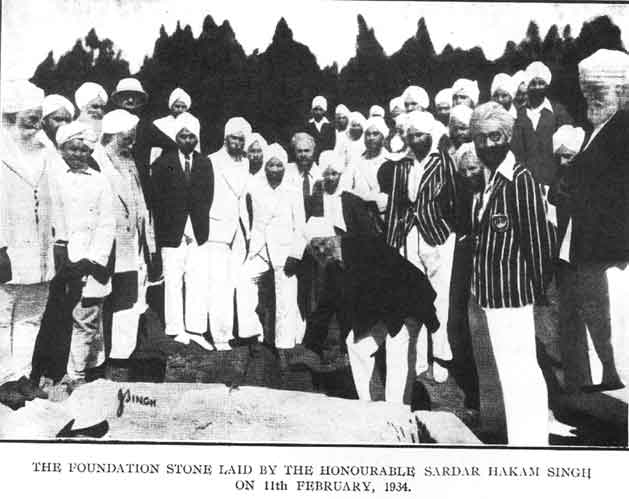
The building was designed by one of Nairobi's most prominent Architects, namely, Mr. C. Rand-Overy, F.R.I.B.A., and was erected, under his supervision, by the well-known Contractor Mr. Lalji Kala. The Club House is 100 feet long, 61 feet broad, and 25 feet high. It comprises two verandahs, one lounge, six rooms, a commodious store and balcony, and is equipped with up-to-date sanitary arrangements. A flight of eight stairs extending throughout the frontage affords additional accommodation for spectators. The cost of the building is Shs. 40.000/-.
Funds have been chiefly collected through donations, theatrical performances, cinema shows, quarterly sweepstakes and by monthly subscriptions and contributions from members.
All the members are well-behaved, well-mannered and well-disciplined, and any Club would he proud of such members.
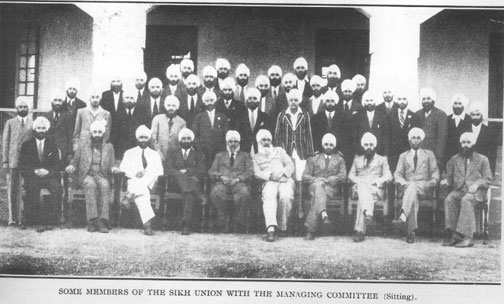
The all-round progress recorded above is not due to a mere chance or stroke of luck, as we are congratulated for, but is the direct result of well conceived and well laid out plans and schemes which have been executed with much energy and determination over the long period of 10 vears.
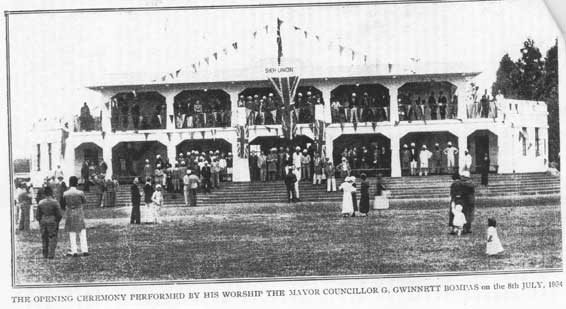
The secret of our success lies in the that we possess a happy energetic band of workers, who thoroughly believe in team work, are self-less and wholeheartedly devoted to the cause. The betterment and progress of the Union has become the mission of their lives and they are fully supported by the General Body, which in appreciation of their services, extended with a unanimous vote the life of the present management for a term of 5 years.
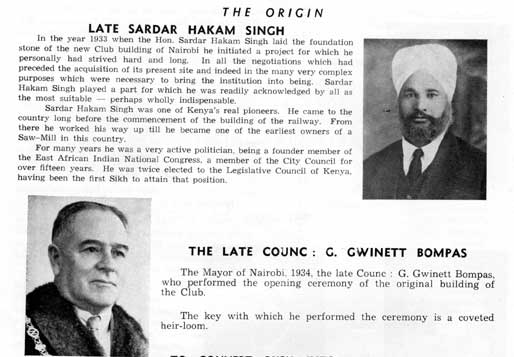
A GENEROUS GIFT.
Sir Sayyid Ali Bin Salim KBE CMG paid a visit to the Sikh Union club on 27th July 1934 and generously presented a cheque for £50 pounds (a very big amount in those days)for acquiring furniture for the club. "Sir ALI Sports Club" for Muslims was probably named after him.
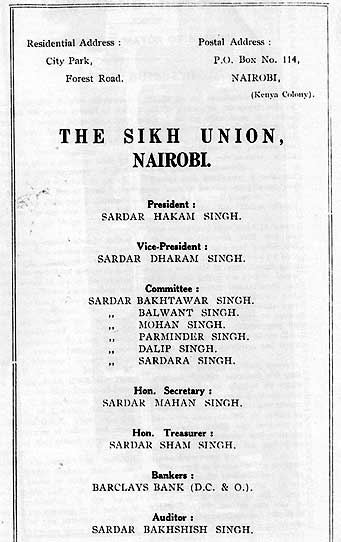
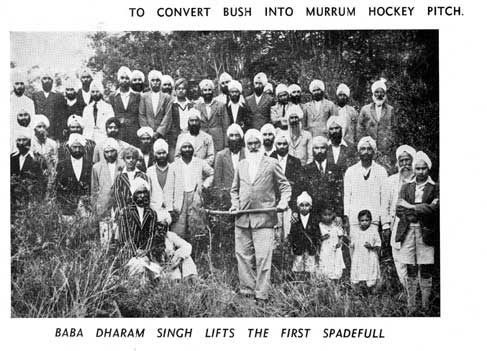
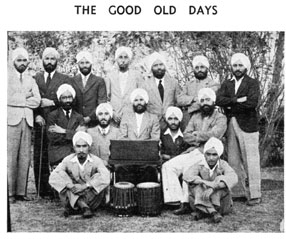
some recognitions: standing 2-Master Ranjit Singh, 3. Gurcharan Singh Guru 4 Mohan Singh,5?6 Sham Singh 7Jaswant Singh master: Sitting 1Mahan Singh 5Babu Meharban Singh & sitting under him Harbans Singh.
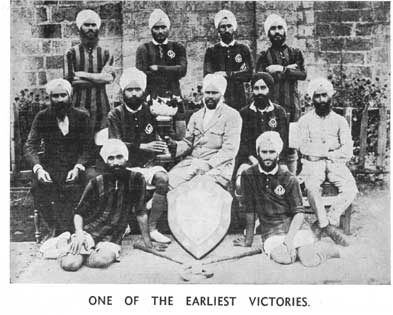
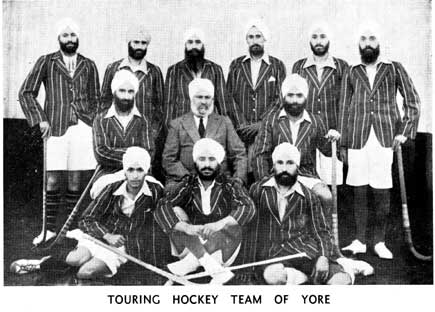
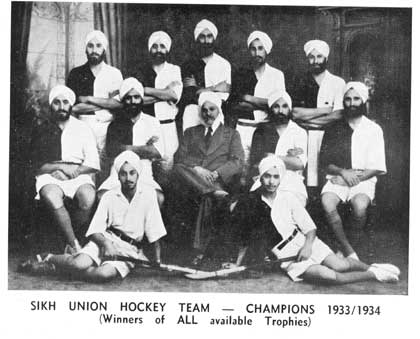
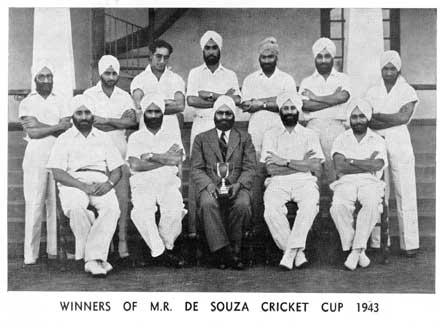
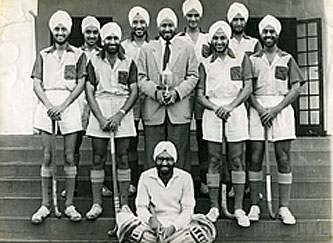
1955 team with Jasmer
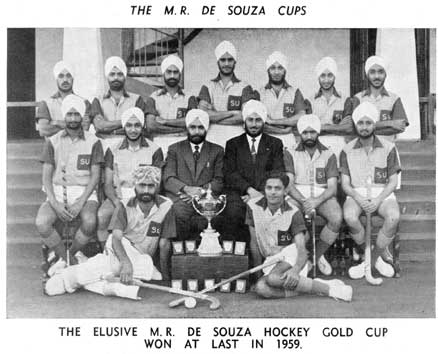
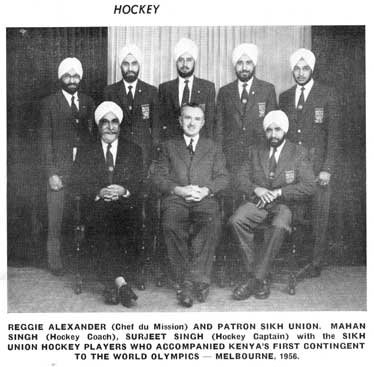
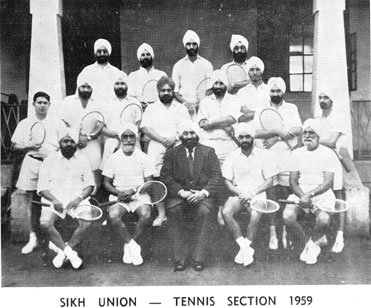
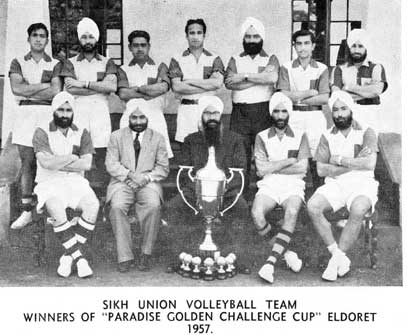
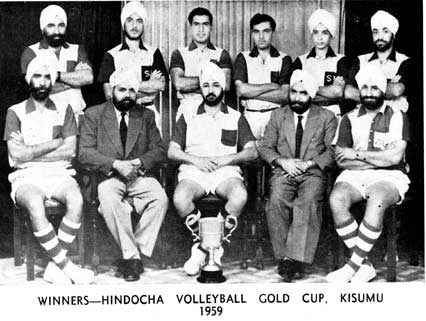
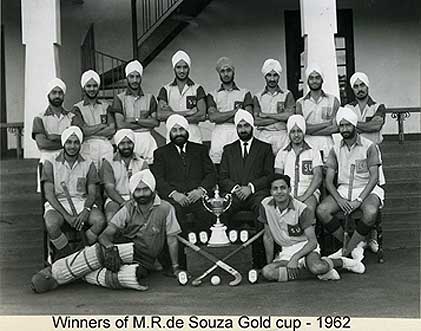
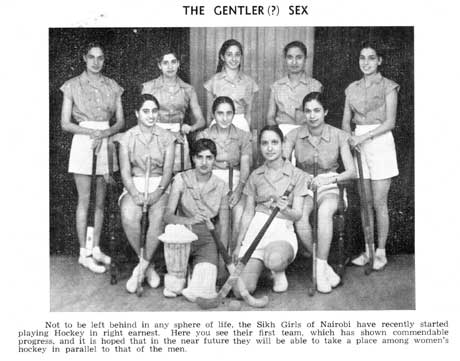
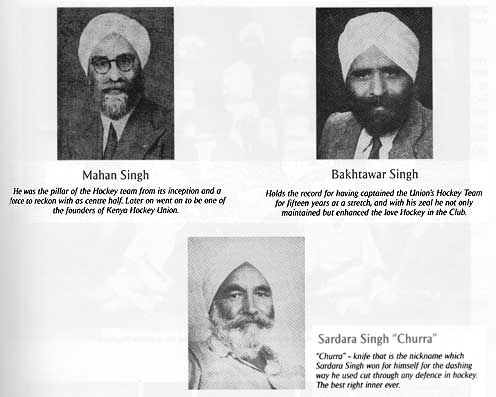
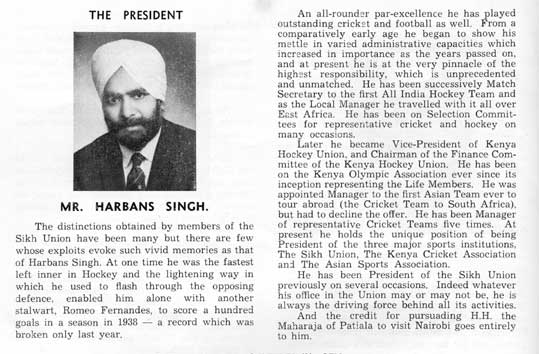
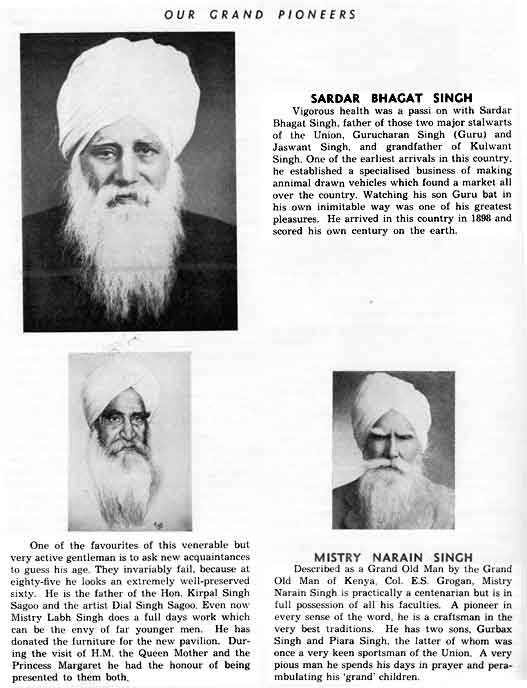
Most of the stuff posted here is taken from a brochure printed in 1959 - so might look outdated now.

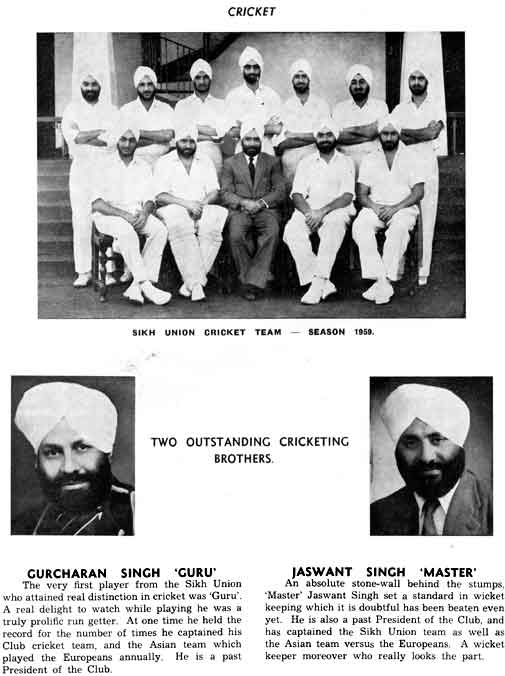
THE SIKHS OF NAIROBI |
Introductory
The Sikhs are readily recogniseable everywhere by their external emblems and dress. The men wear their distinctive turbans and beards. The majority of the women still adhere to the traditional dress of the land of their origin, the Punjab, in Northern India. Its most conspicuous features are the large loose muslin scarf over the head and shoulders and the long, baggy trousers.
The foundations of the Sikh religion were laid nearly five centuries ago. Its cardinal purpose was two-fold —firstly to shed the intricate yet meaningless ritualism which had permeated among the Hindus, which deflected them from their true faith, and the belief in the one and only God; and secondly to overthrow the tyranny and oppression of the rulers of those times.
Sikhism is a completely democratic religion in every way. In the Sikh Temple (Gurudwara) the object of worship and the fount of all solace, comfort and ceremonial in the Holy Book (Siri Adi Granth) which contains the sayings of the Sikh Gurus (teachers) and of a number of saints, Hindu as well as Muslim.
The Pioneering Days
The Sikhs reached the site on which Nairobi now stands along with the then Uganda Railway, i.e. about the year 1896.
They came in considerable strength, forming part of the railway construction labour force recruited from India for specific periods. These Sikh workmen were in the main hereditary carpenters, masons and blacksmiths. With the exigencies of the local demands however, many of them readily adapted themselves to other skills, such as fitters, turners, boiler-makers, mechanics, engine drivers etc. Practically all of them were illiterate. They were of course, without their families.
The major proportion of the policemen who served in the country, particularly Nairobi, till the Africans could be trained for the purpose, were Sikhs including a number of subordinate officers.
With the exception of a few. all the Sikh indentured labourers and policemen were in time repatriated to India. Those that remained were later joined by their co-religionists in ever increasing numbers over the subsequent years. They came into the country under their own steam.
The new arrivals were also mostly artisans though they included a number of semi-skilled and even unskilled persons. All of them however, speedily picked up trades or enterred other useful occupations and helped to build up a virile middle class of the local Asians.
Among those who began to enter the country after the completion of the railway there was always a small sprinkling of educated Sikhs who found ready employment as clerks or as junior police officers.
The Sikhs have always been prominent as doctors in subordinate government employment.
Well before the time when mechanical road transport came into existance, the Sikhs played a conspicuous part in introducing and operating the Indian bullock-cart. Most of the rickshaws of the pioneer days were built and owned by the Sikhs.
During the early settlement of Nairobi when the sanitary arrangements had to be effected through manual labour, it was a number of Sikhs, emancipated from the Hindu untouchable class, who provided the manpower for this essential service. With the advent of water-borne sanitation and the introduction of Africans to this work, the Indian (Sikh) "sweepers" took to other occupations, such as bullock-cart transporters and dairy men. Some of them ended up in solid prosperity. Remnants of this class are still to be seen in Nairobi, though they now ply their rare broom in woollen suits instead of the tattered cotton shirt and trousers of the bygone days.
Up to the comparatively recent times, very few Sikhs stayed in Mombasa on arrival. The destination was almost invariably Nairobi. From here a proportion of them scattered to every part of the country, including the remotest corners. But Nairobi has always been the centre of the Sikh Community of Kenya: indeed there have always been more Sikhs in Nairobi than in the rest of the country put together.
Almost as soon as Nairobi grew out of a railway camp into a township, the Sikhs who had settled here began to have their families brought over. In the early stages regular visits to India were considered to be an indispensible part of their lives, though this practice has since been very drastically curtailed.
From the very outset the Sikhs as a whole built up a very respectable status for themselves.
Their standing however received a considerable stimulus by the arrival, during World War I, of a large number of Sikh Troops from India, a proportion of whom were officered by Sikhs themselves. They fought with outstanding gallantry throughout the East African campaign. Several contingents lived in or passed through Nairobi. Their smart, distinguished turn out. superb manly bearing and strict discipline elicited great praise. A community of 'fundis' and 'karanis' began to be looked upto as the kith and kin of the sturdy fighters for their sovereign and their country.
Present Economic Status
The progress of the Sikhs from the time of their earliest arrivals has in all respects been continuous, steady and impressive. It has not however been as spectacular in so far as wealth is concerned as that of one or two other Asian communities. One of the reasons is that very few Sikhs indeed have found it congenial to engage in some of those forms of trade which have been productive of massive wealth.
The economic status of the Sikh Community however now rests on very firm, if not very opulent foundations. The main reason for this is that Sikhs have diversified their economic activities to a far greater extent than any other Asian community. They have entered all the professions with vigour and in substantial numbers. Sikhs have gained an impressive share of the commercial pursuits of all types, particularly those which demand specialised technical knowledge and organising ability: such as contractors, transporters, furniture makers, etc. They are prominent in the subsidiary industries, mainly as owners of engineering workshops, garages, motor-lorry body-builders, and the like.
In all branches of the civil service the Sikhs hold a very high status, both in percentage of the total Asian personnel and in the positions occupied. They have also built up an assured and respectable place for themselves in the employment of European commercial houses. With the removal of racial restriction in government and partly in commercial service, several Sikhs have risen to substantial ranks. As time goes on there is every prospect of their rising to the highest available positions.
All along, they have continued to maintain their place as artizans and craftsmen. With the development of the mechanical age they have acquired the relevant skills which keep them in steady demand. No community or group has been able to rival them in the manufacture of superior types of furniture, with or without the aid of machines. The railways and allied services are still an attractive field of employment for the Sikhs, for technical as well as white collar jobs and indications are that they will continue to remain so.
A small but conspicuous sphere of the Sikhs is the uniformed ranks of the police. They possess considerable aptitude for the type of work it entails. During the worst phase of the Emergency the Sikhs were foremost among the Asians to volunteer for active service.
The Sikhs own considerable property in Nairobi, mainly in residential, commercial or industrial premises. At the same time they have made substantial improvement in their standard of living, and many have gone as far as possible to adopt the Western style. In this respect however, there is still a fairly noticeable percentage of the community which has not yet assimilated the minimum improvement its financial status can permit.
Religion
Among the Sikhs as among all the people of the East religion plays a much greater part in human life than is the case in the West. A place of worship therefore is always accorded a very high priority for establishing an orderly communal life. Soon after reaching Nairobi, the Sikhs built their first temple (Gurudwara), originally a small temporary structure in the railway 'landhies'.
Around the year 1910, the first substantial gurudwara was built on the Racecourse Road, on the site on which the imposing building of the Khalsa Boys and Girls School now stands. (Khalsa is a term broadly denoting a 'select' Sikh). Judging from the standards of the times, this gurudwara was a remarkable piece of architecture. For a long time its burnished bronze dome was a noteable landmark of Nairobi.
This Gurudwara had to give way to the school and for a number of years the main hall of the School has been utilised for the purposes of th3 Gurudwara. A magnificient new edifice however is being built in the adjoining plot, and the new gurudwara is expected to be ready next year at a cost of about £50,000. Both these institutions belong to the Siri Guru Singh Sabha of Nairobi, which was originally an off shoot of a new reformist Sikh movement in India, but is now affiliated to the organisation which controls the historical Sikh shrines in that country.
In all, there are now six Sikh Gurudwaras in Nairobi, as follows:
(6) Siri Guru Singh Sabha,
- E. A. Ramgharia Board,
- Siri Gurudwara Bazaar,
- Namdhari Sangat,
(5; Balmiki Mandir.
(6) Ramgarhia Railways.
The rapid expansion of the community is an ample justification for the existance of these Gurudwaras, but it has to be recorded that Nos. (2) and (3) were originally formed as the result of traditionally economic cum locally factional reasons, while (4) and (5) are the result of sectional differences. All these institutions are however, extremely popular and financially well off.
It is noteworthy that a Sikh Gurudwara is not only a place of worship; it can be used for secular meetings, as a rest house, and a communal kitchen.
One of the grave problems which faces the Sikhs of Nairobi and throughout Kenya is the lack of any religious instruction for most of their boys. This has already led to several instances of apost-acy in the sense of shedding the external emblems of the faith among the new generation. The leaders of the community are alive to this danger and efforts are being made to impart knowledge of Sikh religion and Sikh history by holding evening classes. An important redeeming feature is that all Sikh girls receive at least the preliminary spiritual training.
Education
Although there were very few Sikhs among the earliest arrivals who were educated, it will live to their credit that they realised the need for preventing the children of the whole community from growing up into illiteracy, in a new country where educational facilities under the aegis of the government were very rudimentary, at least to begin with. In spite of the numerous handicaps of finance, accommodation and teachers, they opened two schools in Nairobi, one for boys the other for girls. Both of them were small institutions and had to pass through many vicissitudes, and at one stage the boys school had to be closed down.
For many years past, however, the Sikhs of Nairobi have shown remarkable progress in the realm of education. The Khalsa Boys and Girls School, already referred to above, is perhaps the largest institution of its kind in the country, with almost 1900 scholars on its rolls. It imparts teaching to the girls in all subjects prescribed for the Kenya Asian Preliminary Examination, as well as religious knowledge on a pre-planned basis. The boys have to leave the school at a fairly early stage and join the Government schools. The teaching of Punjabi (mother tongue of the Sikhs) is compulsory.
The present school building, large though it is, has become extremely overcrowded. A branch school however is under construction on the Mombasa Road. Another branch is likely to follow in Eastleigh.
The record of Sikh boys in government schools is extremely good. The tendency has developed very well throughout the Sikh community to impart higher education to their children, and an ever increasing number of them go to Europe, etc.. for advanced studies. Due to the institution of compulsory marriage, college education among Sikh girls is as yet rare, but the effort is nearly always made to pass through the secondary school stage.
In the government boys' schools of Nairobi, arrangements have been made for teaching Punjabi.
The Sikhs are prominent in the Royal Technical College and in other well conducted technical training institutions. Numerous Sikh lads enter into apprenticeships wherever possible. The acquisition of a skill of some sort, rather than entering into the business of buying and selling has fortunately always held a greater attraction for the Sikhs.
There are three Sikh libraries in Nairobi, Siri Guru Singh Sabha, Siri Gurudwara Bazaar, and E. A. Ramgarhia Board, the last being a recent addition and is proving increasingly popular.
HEALTH
A well-appointed charitable dispensary has been opened by the E.A. Ramgarhia Board. It is open, like the library, to all races.
SPORTS
The Sikhs of Nairobi have always taken very keen interest in sports, particularly in hockey, cricket, volley ball and to a lesser degree in tennis. Among the indoor games the most popular is table tennis.
From very modest beginnings on a plot adjoining the Sikh temple on Race-course Road, they progressed steadily and now have a beautiful club house and grounds on the Forest Road. The creation of this institution called for intense hard work and sacrifice on the part of many enthusiasts, to the extent that in the early stages a good deal of manual labour was provided voluntarily by the members themselves.
The Sikh Union is now in great demand for the more important cricket matches. Its latest extension, the new cricket and tennis pavilion is being opened today (11.12.59) by H.H. the Maharaja of Patiala. Further developments are planned.
There is hardly any trophy open to Asians which the Sikhs have not won in the games which they play.
In the Kenya Contingent which went to the Melbourne Olympic games in 1936, the largest single element, including the hockey coach and the hockey captain, consisted of Sikhs.
The Sikhs of Nairobi can rightfully claim that through sports, they have done outstanding work in promoting closer race-relationship with the Europeans.
POLITICS
Due perhaps to the educational and economic structure of the community, the Sikhs of Nairobi have never taken a really aggressive part in politics. Realising the circumstances of the country they have always been instinctively loyal, though at the same time they have been very cautious to ensure that wherevsr any interests were diverted to a communal basis, they were not the losers.
One of the earliest presidents of the Indian Association of Nairobi was a Sikh, and there have been two Sikhs so far elected to the Legislative Council before the Asian Community was politically split into two. Their representation is now effected through a Government Nominated member, the Hon. Kirpal Singh Sagoo, who was appointed in 1956 at the time when he was President of the Sikh Union, Nairobi — His selection can thus rightly be taken as an honour to the Union itself.
The Sikhs at present hold more than their numerical share on the City Council of Nairobi. ie first Asian Deputy Mayor of Nairobi was a Sikh. (Alderman Mohan Singh)
On other public bodies, however, the community has real cause for dissatisfaction. On the Legislative Council, for example there are five Arab representatives, as against only one Sikh, though the numerical strength of the two communities is the same while the interests of the former are far narrower than those of the latter.
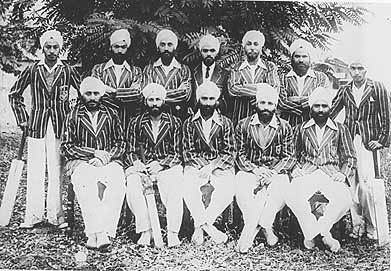
Earlier cricket team of Sikh Union
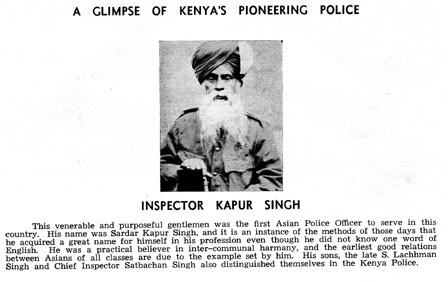

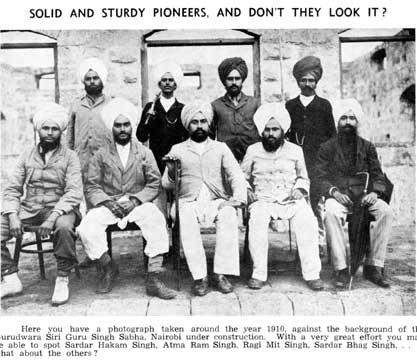
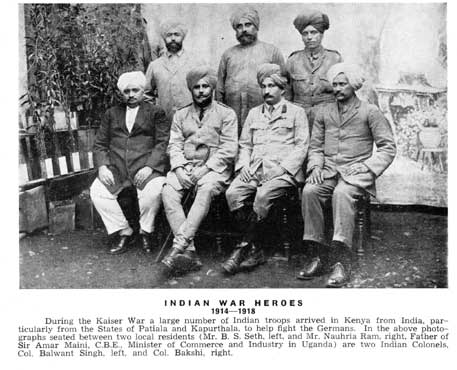
THE PATIALA CRICKET PAVILION
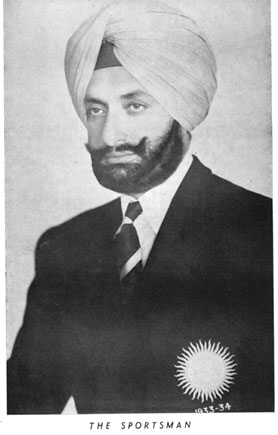
Maharaja of Patiala after whom the Cricket pavilion was named
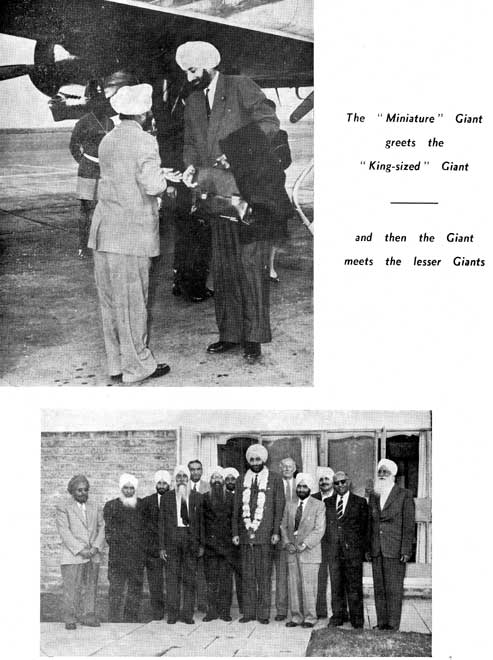
Welcome Address to H.H Maharaja of Patiala
Lieut. General His Highness Maharajadhiraj Rajeswar Sri Maharaja-i-Rajgan, Sir Yadavindra Singh Ji Mohinder Bahadur Yadu Vanshatansa, Bhattikul Bhushan, G.C.I.E., G.B.E., L.L.D.
The MAHARAJA OF PATIALA
Welcome Address by the Sikh Union, Nairobi.
May it please Your Highness,
The auspicious arrival of your Highness on Wednesday morning was to us, the consummation of a keen hope and desire which, although you may not be aware of it, had arisen among us not just a few months ago in connection with the opening ceremony of our new cricket and tennis pavilion, but as far back as the year 1934 when our main Club building was nearing completion. On the 19th February, 1934, we addressed a letter to your most illustrious Father, in which we said 'inter alia':—
"This country abounds in big game . . and is worth seeing. Your Highness may perhaps consider the possibility of allowing the Prince Yuvraj of Patiala to undertake a tour towards these parts. The Prince is sure to enjoy it immensely . . . We shall consider at a great boon and privilege if we are afforded the opportunity of giving the young Prince a reception worthy of his rank and name and many a good game of cricket on our playing fields".
It has taken a long time for our dream to come true, but we can assure Your Highness that it has served to augment our happiness, and to bring it to the extent in which we are feeling it now.
Your Highness is, without a moment's possibility of a question, by far the most eminent Sikh personality in the world of today. But the great name and the great fame which you have won in ever so many sphere of life, have for years spread far beyond the communion of our religion, indeed, far outside the boundaries of the great subcontinent of India to which we owe our common origin. They have become known wherever the admiration for a superb sportsman, the esteem for a great soldier, the regard for a wise and sympathetic administrator and the respect of one endowed with an outstanding perspicacity for all matters connected with the well-being of his fellow men. in transcendence of his own self, are given their deserving status of high merit. By your arrival in this country you have thus done infinite honour not merely to us of the Sikh Union — though we are exceptionally proud of the credit which it brings to us — no, not just even the whole of our
local Sikh Community, but to the entire population of this eastern region of the mighty continent of Africa in which we are inter-racially — and in many ways — uniquely situated.
Your Highness, an address of this type can only be a very short and a very formal tribute. It is impossible to condense into it the dignity we acquire in reflecting on the glorious history of your ancient and most noble house; by describing what just the name of Patiala signifies in the realm of sports of all types, and how much your great Father and yourself have done to promote its love and its standards all over India; by thinking of your unforgettable humanitarian record at the time of one of the greatest crises for our community; by mentioning the peerless part which Your Highness played in swaying the glittering and mighty Princely Order of India towards a completely democratic way of life; or even by relating the extremely useful and competent contributions which independent India has gained through your unstinted and unswerving services in representing her in ever so many inter-national conferences and conclaves. We must content ourselves by saying that in you Mother India has a son who has done his duty towards her in several unrivalled ways, done it nobly and done it well.
Your Highness' stay in Kenya unfortunately has been extremely short. May we hope, Sir. that what you have seen of it and its people, will be an incentive for another and a longer visit ? With your long tradition of watching and judging human life in all its aspects, can we believe that, contrary to the impression which so unhappily exists abroad, you have found in this country of ousr three different races, Europeans, Asians and Africans leading a happy and progressive life ? We are confident that we can.
On behalf of the Sikh Union of Nairobi, Sir,
I now have the greatest honour, as its President,
to present this humble address to Your Highness.
We beg to remain Your Highness's
Most Obedient and Humble
Servants, THE SIKH UNION. NAIROBI.
Harbans Singh, President.
Tek Singh, Vice President.
Mota Singh, Secretary.
Mohinder Singh Lyall, Treasurer.
Kirpal Singh Sagoo, M.L.C. Committee
Member.
Jaswant Singh, Committee Member.
Kirpal Singh Sehmi, Committee Member.
Jasmer Singh, Committee Member.
Dr. Ranjit Singh, Committee Member.
Harcharan Singh Mangat, Committee
Member.
Gurbachan Singh Sehmi, Asst. Secretary.
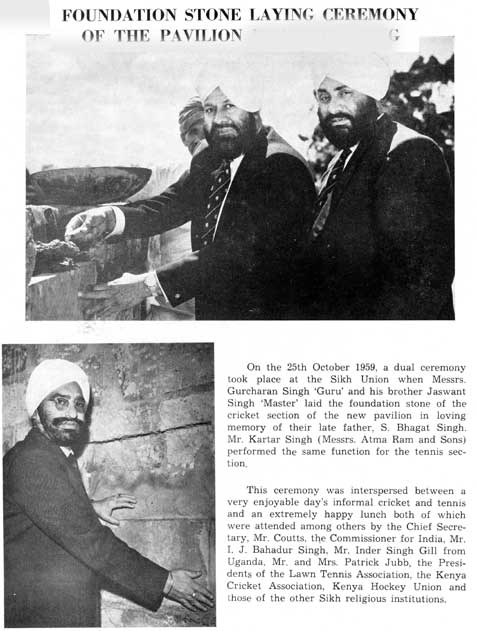
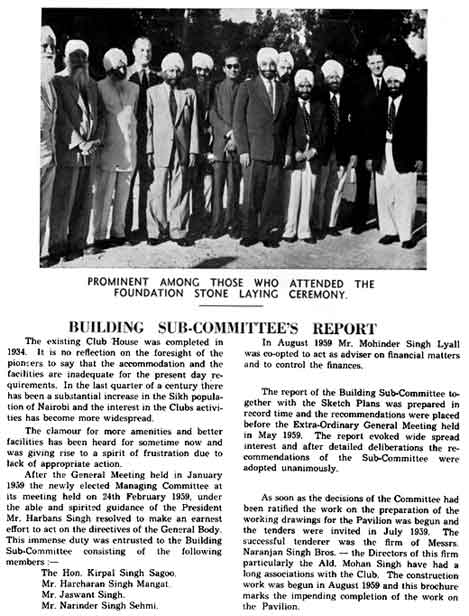
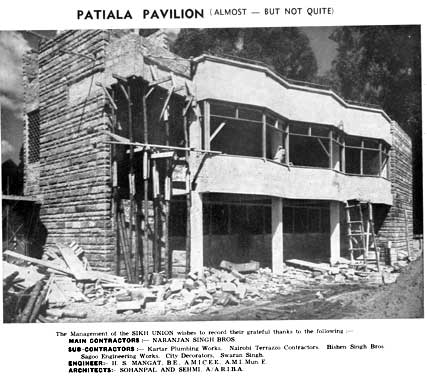
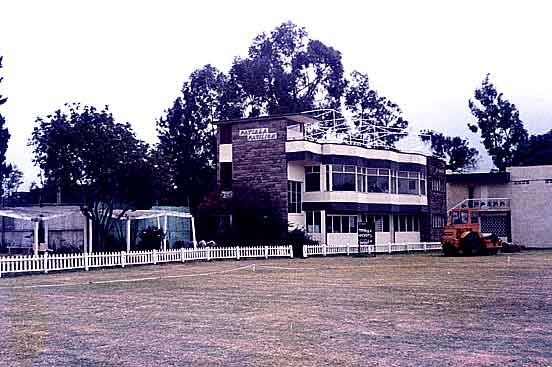
Patiala Pavilion 1985
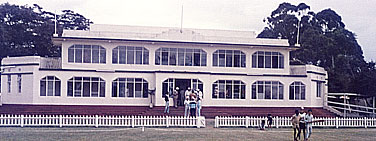
Sikh Union (Simba Union) Club house snapped during my visit 1985
Other Sikh Union Clubs
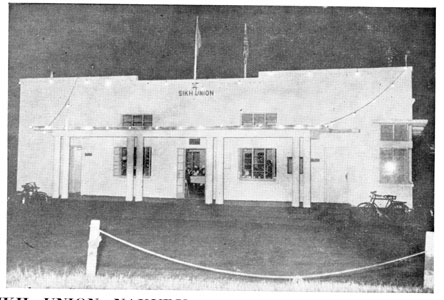
SIKH UNION NAKURU
Sikh Union Nakuru was formed in the year 1951, and the following year saw the members enjoying their own Club house and the credit for this magnificent task goes to the founder-officers Messrs. Jodh Singh and Narinder Singh Calay, both of whom are not here today, as they have been transferred to Nairobi.
Its opening ceremony was performed by the then Governor of Kenya, Sir Philip Mitchell, G.C.M.G., M.C., who every kindly accepted to become its Chief Patron as well.
Apart from sports, social and cultural activities, the Union has greatly contributed towards improving relations amongst its members and members of the other communities, and enjoys the patronage of various prominent non-Sikhs, distinguished amongst whom are the Hon. Michael Blundell, Hon. Norman Harris, Hon. W.B. Havelock, and Mr. Norman H. Hardy, O.B.E., former Mayor of Nakuru.
During the year 1952 the Union-management introduced a "Gold-medal for Merit" and has over the years made 14 awards to the distinguished persons of all races.
Amongst the recipients are the two retired Governors of Kenya, Sir Philip Mitchell, G.C.M.G., M.C., and Sir Evelyn Baring, G.C.M.G., K.C.V.O., and the present Governor of Tanganyika, Sir Richard Turnbull, K.C.M.G.,Since 1954 the management has been in the able hands of Mr. Pyara Singh, (President) and Mr. Daljeet Singh Brar, (Secretary).
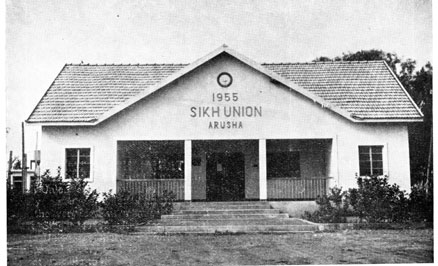
SIKH UNION ARUSHA
The history of a great man is written for his material achievements in life whereas the history of an institution is written for the development of these achievements in man. The Sikh Union, Arusha can proudly be known as an institution that has brought a tremendous change in the development of sports in the town.
Started in 1952, by the few pioneers, the Sikh Union, Arusha, took its birth under a small shady tree that stands to day as a symbol of love and co-operation, in its grounds. A handful of sport-minded youngsters sponsored an idea of making the place a small playground which developed by and by into a grand institution. A year later, land was acquired from the Town authorities and the valiant players joined hands to develop grounds for hockey and volleyball. The budding players impressed the people around to such an extent that a regular institution had to be set up for catering for the sports requirements of the Sikh community in particular and the public in general.
With a registered name of Sikh Union. Arusha, a constitution was framed in 1954 and the building for the union was started for the convenience of the members, players and the guest teams. The paucity of funds was a great drawback but was overcome by holding two Fetes and depending on the generous help of the big business magnates in the Sikh Community, and by enrolling 28 Life members, the building was completed in 1955. From the year onwards, the Sikh Union has offered opportunities to one and all for proving their sports talents in Hockey, Volleyball and Badminton.
The Tennis court has been added in 1958-1959 and plans are in hand for another Tennis court in the near future. The membership is not primarily restricted to the Sikh Community and is open to all the communities. The Union grounds are the best maintained and it appears a colourful sight to witness the jolly children, promising teen-agers and the top class players, busy every evening, playing Hockey, Badminton, Volleyball and Tennis outdoors and the rambling others enjoying a game of Cards, Carem-Board and Ping Pong indoors.
Many provincial teams, upcountry clubs and inter-territorial players visit the Sikh Union every year. Great sports events like Sikh Union Cup played during bank holidays, athletic meet on Baisakhi day and competitive trophies offered by sports lovers have become the annual features.
SIKH UNION MOMBASA
The Sikhs enjoy an enviable position in sports and athletics in India. This prestige, they have not only kept but enhanced in this Colony. Here, on the Island, with a view to establishing an organised sports institution, a meeting of the Sikhs of the Island was held on 27-9-1931, wherein this necessity was discussed and a committee elected to put into being a club, to be called "THE SIKH UNION". The Committee under the presidentship of Mr. Budh Singh worked arduously and met with an enthusiastic support from all the Sikhs. And the present prosperous state of the Union has been attained through the untiring efforts of the successive Managing Committees.
SPORTS GROUNDS
The first necessity to establish a Sports Club is a suitable plot for the playgrounds. As a temporary measure, the Railway Administration, through Capt. G. Nisbet, Senior District Engineer, Kilindini, was approached for permission to improve and use the piece of land, which now comprises the approaches of the Beach Line Junction. The request of the Union was acceded to by Capt. Nisbet, who allowed the use of the site free of rent, where the Union carried on for about three years.
The local Government was approached for the present plot, as it had a central position for majority of the members of the Union. The councillors, both the officials and the elected, sympathetically considered the application and granted lease of the plot for 25 years at an annual rental of Shs. 72/- as from 1st January, 1935. This plot has been improved to accommodate a Hockey pitch, Volley-ball, Tennis and Badminton courts. To introduce Foot-ball and Cricket, for which necessity was increasingly felt, an extention of the present plot was needed. To make up this deficiency, a portion of the adjacent plot was procured on rental basis from 1st September, 1937. In this respect, Messrs. Smith Mackensize & Co. Ltd. very kindly made the necessary arrangements with the owner (Mrs. Sim). Now again this plot is not a part of Union grounds.
Mr. Shiv Singh opened the Hockey Ground on 9-1-1936 and donated a handsome amount towards the funds of the Union.
CLUB HOUSE
With increasing prosperity, a change from the shelter of a mango tree to that of a roof was desired. The present club house was therefore the outcome, which cost a sum of Shs. 3,000/00. This cost was kept at this low level by the love-labour of its members and well wishers, the timely purchase of an old wooden aid iron house from the Railways and the favour of the building-material merchants for charging minimum profits.
Its foundation stone was laid on 30-6-35 by Sardar Hardial Singh of K.U.R. & H. who donated Shs. 200/- and Doctor Hazara Singh performed the opening ceremony donating a liberal sum of Shs. 1,000/00 on 26-1-1936.
The need for a new club-house has long been felt and the management is already preparing plans for it. The present club-house is very small for the increased and multifarious activities of the club. In the last few years the Sikh Union has made a tremendous progress especially due to the initiative and keen interest of its younger members and very generous contributions by the Sikhs of Mombasa as well as some of its non-Sikh members.
NEW CONSTITUTION
The club has recently revised its constitution according to which membership of the club has been thrown open to people of all races for promoting better understanding and friendship amongst the members of the various communities.
HOCKEY
Hockey is the main game played at this Club and we have one of the best teams of Kenya. Last year we were the winners of the Mombasa Knock-out Cup and this year we have already won the Hockey League Championship and also the Singh Study Circle Cup.
TENNIS AND BADMINTON
The tennis court was first opened by Dr. Hazara Singh on 28th February, 1937; then after long use as the court needed re-surfacing, the game was discontinued for quite a while. We have now almost completed a new tennis court and the game is to be re-started by the end of this month. A new badminton court is also under construction.
VOLLEYBALL
Volley-ball is another popular game; it was, in fact, the first game to be introduced in the club and we won the Mombasa Volley-ball Cup as early as 1937.
CRICKET
Cricket is also played at the club but the greatest handicap is the lack of enough ground-space for making a suitable pitch.
Since last year special efforts are being made to stimulate interest amongst members and the school-boys in athletics. The performances of the Sikh boys in School athletics were very creditable indeed.
The club also regularly arranges talks, film-shows and social functions besides providing various types of indoor games.
The Sikh Union Club is thus taking the Community forward in all spheres of life-physical, social and intellectual. It also plays an important role in bringing the members of various communities of the town closer; as such the management is very keenly looking forward to the day when its plans for a new, bigger and modern club-house will materialise.
HOCKEY
By MAHAN SINGH.
Note: This article was written over twenty-three years ago. It is a remarkable proof of Mahan Singh's knowledge and psychological insight of the game, that every word of it is as true today as it was then.(1959 article)
Hockey, like most things in the world, is changing for the better.
In this game, there is now hardly any physical contact amongst the players, or, to be more accurate, there ought to be none. Essentially, it is a stick and a ball game only. Of late, it has been so much improved that any danger to limb or life has been absolutely minimised. Moreover, the construction of level murram pitches and the strict application of rules have helped to eliminate the chances of any bodily harm. For an able bodied person it is now simply a pleasure and a joy to indulge in the game.
The standard of the game is going up by leaps and bounds. With the influx of new players from India — the home of hockey — the most recent methods of play have been adopted in this Colony and are being exploited to the full. Up to recently, hands, legs, and feet were freely used by the players to stop a ball, which involved loss of time in getting the ball away. The majesty of style was robbed thereby and clumsiness was the ugly feature of the game. On the other hand, by using the stick only there is gain in time which is so essential in beating an opponent. The abandonment of this hand, leg and feet habit has also resulted in excellence of stick work.
The most essential thing in hockey is to master the art of receiving and passing the ball most accurately at the right moment, and when in the ring to shoot through the space between the poles most correctly. Flexibility in limbs and muscles renders easy and quick movements which help a lot to take a shot from an angle.
Dribbling is indulged in by most of the players. At the beginning, it may bring them some applause from the spectators, but continuance of this habit merely brings jeers and barracking even from one's own supporters and frowns from one's colleagues. Dribbling has developed into a chronic habit. Precautions should be taken in the beginning to avoid it. Once in the system, it is very difficult to get rid of it, just like malaria.
There is a great difference in the methods of play of Indians and Europeans. The former mainly rely upon quick stick work, but not necessarily speedy foot movements, whilst the latter depend mostly on dashing tactics. The blending together of these two great qualities, viz., the wizardry of stick and lightning-like speed, produced the real hockey player. That should suffice for individuals, but it is a game between two elevens. Individual efforts, if not directed to the common purpose, will be unavailing. It requires team work, a combined endeavour, and it is there that the Europeans get the upper hand. This is a lesson well worth learning.
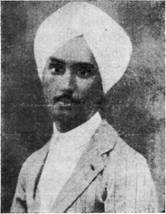
Mr. MAHAN SINGH
If there could be a tornado in human from, it would be found in that wiry, irrepresible and inspired person, Mr. Mahan Singh. Both at wark and at play he has passion for setting an objective which most others would consider as impossible: but in spite of opposition, of disuasion or discouragement, Mahan Singh will toil and perser-vere day in and day out and ultimately win through.
Mahan Singh is Sinkh Union personified. Others have served it faithfully and well, but Mahan Singh, in the days when the very idea of a permanent Asian club building was consider-red as more idealism, made the Union his dream which he had to convert into a reality. And as in every other thing, he eventually succeeded.
Hockey owes more to Mahan Singh than to any other single individual. He has made the most scientific study of the game and has played is superbly himself and taught others how to play it. The Kenya Hockey Union owes its existence mainly to him. He is its present President. In the Olympic Contingent which Kenya sent to Melbourne in 1956, Mahan Singh was the Hockey Coach.
His activities have included taking part in debates and dramatics, and he has served the Sikh education well as the Manager of the Khalsa Boys and Girls School.
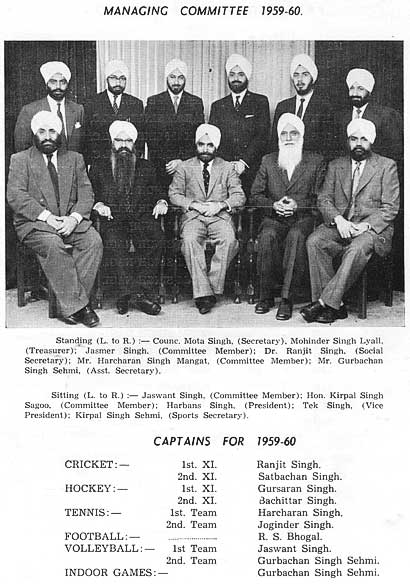
A TRIBUTE TO THE EDITOR
from
THE PRESIDENT OF THE SIKH UNION
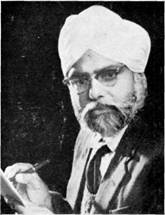
Mr. Narain Singh is obviously annoyed at the interruption. Understandably so, because when "Narain" has his pen poised that way, the sheets begin to fly. But covered with what exquisite English do they fly! And what unbiased and independent judgement, what power of analysis, what extent of erudition does that exquisite English wrap ? What is true of his pen is of course also true of his typewriter. More. I have known him all my life, but "it was only while he was compiling this brochure that I had the opportunity of watching him dictate. For three hours at a stretch, without a moment's pause or without reference to any notes, he poured forth a Niagara of words which for their beauty and grandeur were also equal to those majestic Falls.
Born and educated in Nairobi, where he was the first Asian in East Africa to pass the London Matriculation Examination (which he did in the year 1927, in the First Division and from the Government Indian, now the Duke of Gloucester School) Mr. Narain Singh went to India in 1939 on leave but became 'stranded' due to the Hitler War.
It was in 1954 when I was on my own leave to India that I persuaded him to return to Kenya. I can therefore rightfully claim the credit for bringing out someone who has so effectively filled a void in our community which had yawned from the very outset and had been given up as hopeless.
Mr. Narain Singh is now a journalist of outstanding distinction. He is a free-lancer. His column as the "Asian Correspondent" of the SUNDAY POST is very widely read. Indeed whoever reads the SUNDAY POST reads the Asian Correspondent. It is his courage, his ability to call a spade a spade along with the other qualities I have, mentioned which command so much popularity for him. He also contributes to the STATESMAN of Calcutta and New Delhi and to several other journals. He has experimented with broadcasting with so much success that he intends to take it up as a regular side-line.
The Sikh Union must consider themselves very fortunate indeed in having had the services of a journalist of such impressive merit as Narain Singh to compile this brochure, most of which, needless to say, is written by him.
HARBANS SINGH, President.
EPILOGUE
The Sikh Union has thus led a varied and rich life. It has learnt many lessons from its diversified experience and has done its best to profit from them. At the moment it is in the midst of a scheme of considerable capital investment, which will add very substantially to the amenities provided by the Sikh Union.
In the days to come, the texture of our social institution will change materially, as the result of the re-orientation of our outlook towards the other races, communities and even denominations. The Sikh Union is happy to reflect that it is already very favourably placed to undergo this phase of change, in view of the trend of its own history. It has as its very firm purpose to lend all its efforts towards the happiness and well-being of all the people of Kenya to the utmost extent to which it can and is confident of its success to this end.
SIKH UNION --POST 1959 to 1984 (50 Years of sports)
THE opening ceremony of the cricket pavilion in 1959 coincided with the club's Silver Jubilee. The next 25 years have been years of consolidation in the development of facilities, sporting achievements on the field and contributions by the club's administrators and players at national and international level.
Developments
LOOKING at the requirements of the day and the future, extensive plans were drawn up in 1973 to enlarge the club hall, which caters for two badminton courts, functions, a cosy bar, kitchen, a squash court, sauna and other facilities. The foundation stone to the extension was laid on August 9, 1974, by Gurdial Singh Sian and Milkha Singh Sian.
These extensions were carried out at a leisurely pace, depending on the availability of funds, by Mr. Swaran Singh Bansal. The first squash court at the club was completed and the opening ceremony was performed on March 22, 1975, at a colourful ceremony by the Jandu brothers, laswant Singh Jandu, Bakshish Singh Jandu, Pritam Singh Jandu and Mohinder Singh Jandu.
All other extensions and amenities were completed in 1977 and the opening ceremony was performed by Mr. Tara Singh Channa and Mr. Avtar Singh Channa, of Coronation Builders, on April 13, 1977, before another colourful and distinguished gathering at which The High Commissioner of India, Air Marshall Arjan Singh, was present.
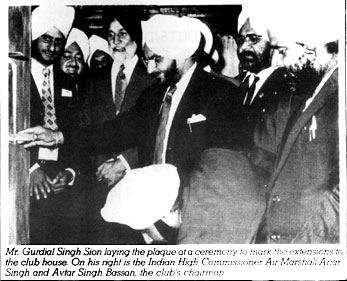
The extentions were carried out by M/s Bansal Brothers Ltd, (Mr.Swaran Singh was one of the directors, but he did not do the work by himself. ) The photo includes Mr.Balwant Singh Bansal - also known as Bawa Singh Bansal on the extreme right.
Being one of the leading sports institutions in the country and keeping in mind that if our sportsmen have to keep pace with others, modern facilities are essentiaj. As a result of this, in 1980, it was decided to do away with the murram cricket pitch and put in a grass square. This, indeed was to prove an expensive venture, but it did not deter the enthusiasm of the committee.
In front of all the club's cricketing fraternity, management committee an supporters, Mr. Tara Singh Virdee, of E.A. Electrical Co. Ltd., performed the digging ceremony in 1981. It took nearly 18 months to get the wicket ready and the cricket team had to spend two seasons using facilities of Nairobi Gymkhana and Impala Club. The wait was worthwhile and the first match on turf was played in June 1982.
With squash becoming more and more popular, the feeling was that another squash court was needed and the Bachhu brothers, Mr. Bal Singh, Balbir Singh, Pall Singh and Sulinder Singh, offered to donate a second court to be built entirely at their own expense in memory of their late father, S. Hardial Singh Bachhu. This the Bachhu brothers did, and a modern court was completed in 1983. The brothers performed the opening ceremony on July 8, 1983.
Developments in an institution like ours never stops and, to commemorate the Golden Jubilee, the committee has decided to tarmac the entire parking area, provide lighting and improve the entrance facade with new gates.
It was around 1956 that the second-generation members started taking more interest in the management affairs of the club when. Kulwant Singh, D.S. Jhally, Mota Singh, Jasmer Singh, Hardial Singh, Dr. Ranjit Singh and Tochi Sehmi came onto the management "board". It was Mota Singh, from this group, who became the first President in 1963, followed by Hardial Singh, Jasmer Singh and Kulwant Singh.
While Hardial Singh and Jasmer Singh have continued to play an important role in the committee since, they were joined by Avtar Singh Bassan in late sixties - and the three have been instrumental, to a great extent, in guiding the affairs of tht; club with a team of committee members like Jamsher Singh Panesar, Tara Singh Virdee, Didar Singh Channa, Mohinder Singh Birdee, Dhanna Singh, Avtar Singh Channa and Mohinder Singh Jandu, Dr. J.S. Sokhi, who have been onthe committee sometime or the other for three or more years.
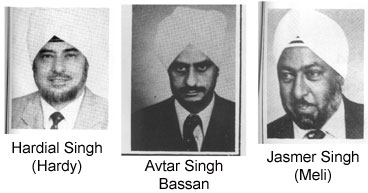
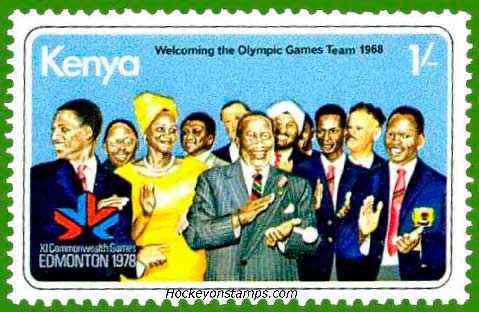
Stamp to commemorate the Kenya Olympic team 1968 where Hardial (Hardy) was the coach of the hockey team. (Courtesy Dil Bahra)
Hardial, Jasmer and Avtar have been honoured with an honorary patronage for their vital services. Avtar has been a chairman of the club for nine years, only the second-longest term to late Hakam Singh M.LC. who was the President for 11 years.
Sports
THIS Period was dominated by two sports hockey and cricket, with badminton and squash coming into prominence in the last three years.
HOCKEY: We continued to dominate in this game at club level and providing the bulk of the players for the national team. In fact, it would be fair to say that our club had earned the unofficial title-of club champions of East Africa. There is not a single hockey trophy in th country we have not won and, on numerous occasions in a season, we won all tournaments played.
We won the prestigious MR. D'Souza Gold Cup for the first time in 1959 at our seventh attempt but thereafter have won it 14 times and have completed the hat-trick twice. It is also claimed we have never lost one of the oldest hockey trophies around, the Joseph & Sons Shield, since the early thirties ... a unique record.
The hockey team has been on three successful tours overseas. Perhaps the best was in 1975 when we toured India and Europe, we played 22 matches and lost only one.
On the national scene we have provided the bulk of the players for the Kenya squad and there was a time when 10 of the players came from Simba Union. The captainship has been in the hands of a Simba Union players for moie than 20 years ... from Surjeet Singh Deol to Avtar Singh Sohal to Surjeet Singh Rihal.
The following players have represented Kenya:
Surjeet Singh Deol, Gurdial Singh, Hardial Singh, Hardeve Singh, Avtar Singh Deol, Nirmal Singh, Bachan Singh, Gursaran Singh, Tejinder Singh, Joginder Singh, Avtar Singh Sohal, Surjeet Singh Sindi, Kirpal Singh, Tejparkash Brar, Krishan Aggarwal, Amar Singh Mangat, Hillary Fernandes, Jack Simonion, Davinder Singh. Amrik Singh, Ivo Colaco, H.S. Grewal, Ravinder Laly, Ranjit Sehim, Leo Fernandes, Harvinder Sibia, Santokh Singh, Jagmail Singh, Pritam Singh, Resham Singh, Tarlochan Channa, Amarjeet Singh, Harvinder Singh, Satpal Singh, H.S. Mangat, B. Riga, Jera Panesar, Manjit Panesar, Nindi Channa, Surjeet Rihal, Narandas, Karamjit Singh Grewal and Nahar Singh.
In hockey umpiring, the late Charn Singh (Chan) and Sheikh Dawood, both World Cup and Olympic class officials, had the distinction to umpire at the 1972 Olympic Games. Chan was also at the 1971 World Cup in Barcelona, Spain.
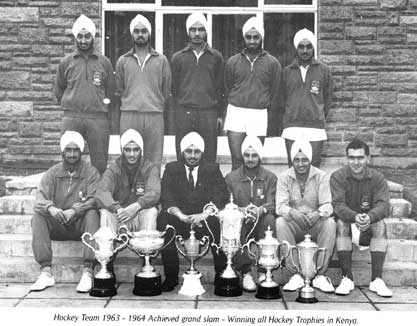
In administration, we have supplied
officials for the International Hockey Federation, Kenya Hockey Union and Nairobi Hockey Association in key positions.
CRICKET: Although the cricket section cannot match those achievements on the hockey pitch the club enjoys a good reputation on the oval as a sporting and hospitable team. We have reached the final of the knockout tournament four times and have occupied third position in the league once.
That may be, but we have continued to provide players for the national team regularly and, before that, for the representative matches betwen Asians and Europeans.
Our stars who have represented Kenya are:
Mota Singh, Mohinder Singh, Gursaran Singh, Jasmer Singh, Daljit Singh, Dr. Ranjit Singh, Mai.Shuttleworth, Charanjive Sharma, Mahesh Patel, Manohar Singh, Rajinder Sood, Jarnail Singh, Jagjit Singh, Baldev Singh, J.S. Shandy, K.S. Mankoo, Kenneth Odhiambo.
On the administrative side our members have played a prominent role at national level and in the last 25 years, Simba Union members have occupied the position of chairman of Kenya Cricket Association for 16 years.
BADMINTON: This sport came into prominence in 1977, when the extensions to the old hall were completed. And we made the grade in 1982 when our team won the Division I league title, having only moved up from Division II the same year. A tremendous achievement for such a new section and, once again, we contributed players and administrators to the national team and national body.
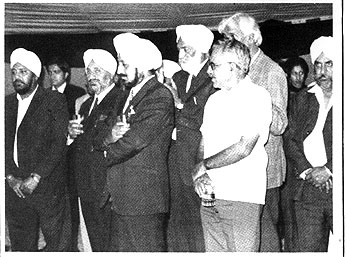
Jandu Bros. opening the first squash court at Simba Union
SQUASH: This is a popular sport at club level with no few than four sponsored' tournaments organised each year. We have not yet produced any national players, but the time is not far off when we will. Our-teams take part in the Milligan Cup league and in 1983 we won Division VI.
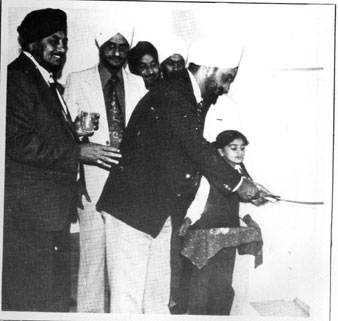
Bal Singh Bhachu cutting ribbon at the second squash court
OTHER SPORTS: Table tennis and darts are two other popular indoor sports, but tennis and volleyball are dormant although we had an excellent volleyball team in the fifties and sixties.
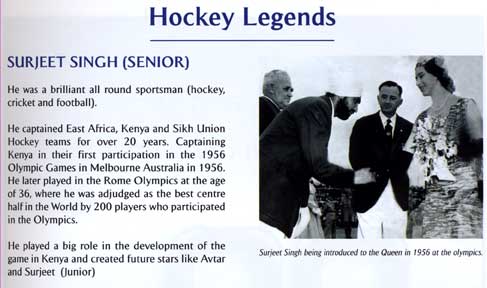
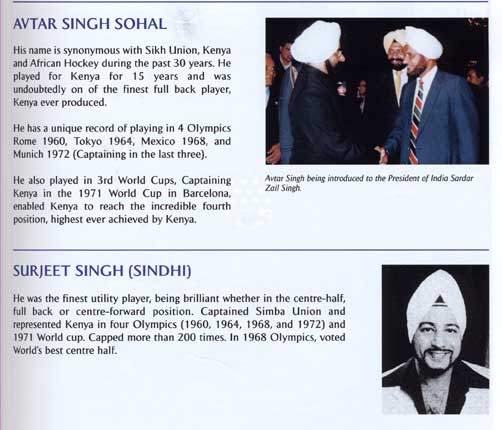
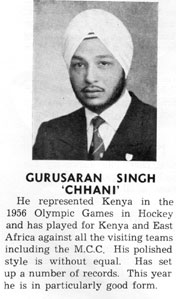
Gursaran Singh 'Chhani', a Sportsman who has represented Kenya as a 'captain' in 'Three' sports - Cricket, Hockey & Golf. (What a sportsman!!)
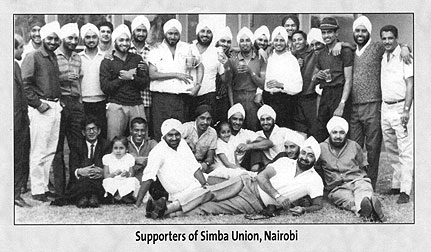
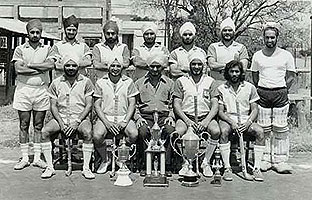
1973 team with Avtar Bassan
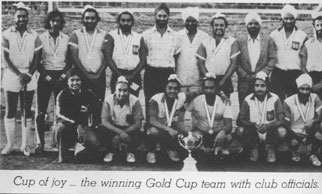
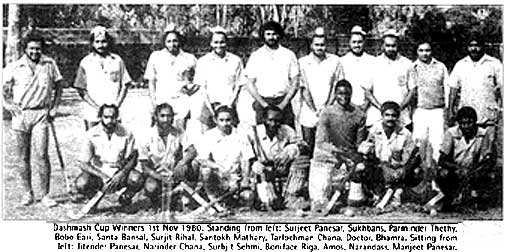
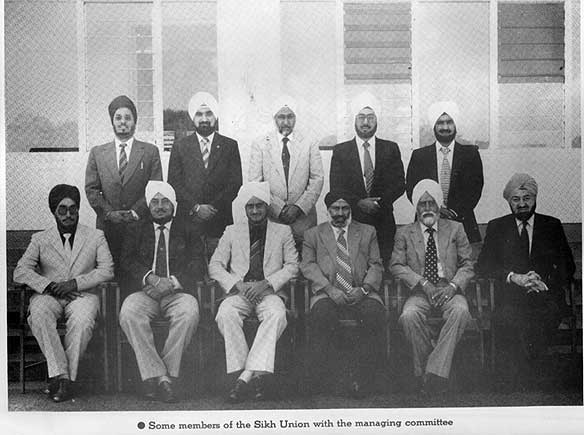
Managing committee 1984
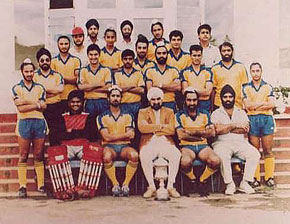
1989 Simba Union team with Dr. Sokhi
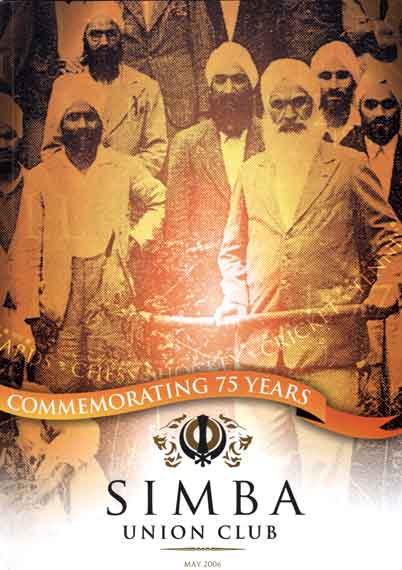
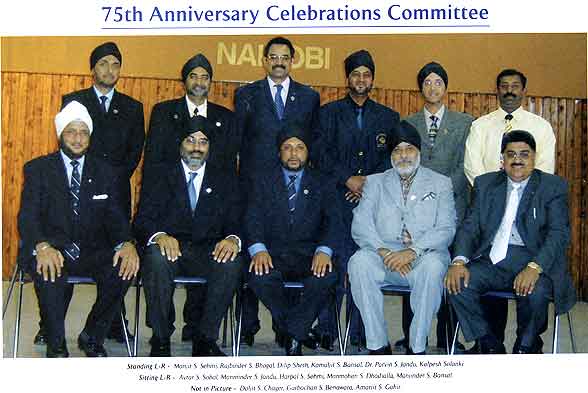
Some recent material supplied by courtesy of Harpal Singh Sehmi, sitting in middle (Thanks- harjinder )
The following article on Sikh Sports is by Jasmer Singh, one of the finest Cricketers of Sikh Union and East Africa and a very prominent member. In this article he narrates the contemporary sports achievements by the Sikhs in East Africa. As this article was written in 1966, it might look outdated at present.
SIKHS
EXCEL IN SPORTS
By JASMER SINGH Grewal
President
Sikh Union
"La Patrie Reconnarssante"
are the words that stand inscribed on a memorable monument in Paris as a token
of tribute of the nation to one of those honoured France most. In the same manner,
though in a very modest way relative to the position of a small community, and
a small 'activity in its daily commitment the same three words, so expressive
of gratitude may likewise be regarded as befittingly applicable to a small band
of people, who contributed much in laying a solid foundation in sport for successive
generations to maintain it in its high tradition.
To judge from the frequently
expressed opinions, coupled with the fact that the Sikhs take part in many varied
events, supports the contention that, the Sikhs are not only the most sports minded
people in East Africa and for that matter all over, but are equally proficient
on and off the field in all departments; of sport, be it Hockey, Cricket, Motor
Racing or Golf.
Hockey and Cricket monopolises the attention of the majority of our sports enthusiasts. For the sport of Hockey is in the heart and blood of every Sikh is not far from the truth. The game has always been most popular, going back to 1930's, Sikhs had outstanding players like Sardara Singh, Joginder Singh Grewal, Bachittar Singh, Harbans Singh and Mahan Singh., although the number of those who were able to participate in it at that time was relatively small, it is an un-desirable fact that some of the early pioneers strived hard and contributed a great deal of practical effort to raise its standard and making sure that this game flourished in Kenya.
The very first Sikh hockey player to come to Kenya was Mr.Satbachan Singh former chief in-spector of Police. (see part one)
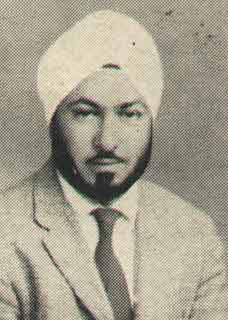
But by far the most colourful and outstanding player from the community has been Surjeet Singh Deol, who for nearly eighteen years occu-pied a prominent role in Kenya and East African Hockey, Captaining the Kenya team to the first ever Olympic participation in 1956 at Melbourne. He captained East Africa also on many occas-ions.
The
stature of Sikhs in Hockey can be gauged from the fact that the Sikhs have formed
the bulk of the Hockey contingent to the Olympic games. Eight in 1956, Nine in
1960 and six in 1964.
Avtar Singh captained the 1964 team to Tokyo Olympics.
There would be very few clubs in- the Country, where one would not see a
Sikh among its ranks, and at the moment there are six Sikh players in the Kenya
team and many more on the verge of recognition.
-The greatest rivals- of the
Sikhs in hockey in this Country are the Goans. It is another? excellent example
--of the contribution which sports can make towards the betterment of inter-racial
and inter-communal relationship - that whereas 30 to 40 years ago there was a
great deal mutual antipathy between these two communities- hockey has served to
bridge the gulf and now we are at a stage where Sikhs and Goans have a great deal
of respect and esteem for each other and more so form about 90% of Kenya's hockey
team.

CRICKET: Not as popular as hockey, but Sikhs have done well in this sport, going back to 1930', it is cricketers like Waryam Singh, Sham Singh, brothers (Jaswant Singh, Gurcharan Singh, Guru) and Harbans Singh who were the early stalwarts, and as far back as 1933 three Sikhs played in the first ever Asian-European matches. In the later years Mota Singh, Mohinder Singh, Swaraj Singh, Parduman Singh joined the repre-sentative ranks. But by far the outstanding Sikh cricketer has been Gursaran Singh, who holds many Kenya records, and captained the Asians and Kenya. Others who have gained representa-tive honours are Daljit Singh, Dr. Ranjit Singh the most colourful personality- seen on a cricket field in East Africa and Manohar Singh.
Sikh Union Nairobi had another versatile cricketer in Varinder Singh Lamba [below] (now residing in Toronto -Canada), who had the honour of captaining the Sikh Union side for six consecutive years. A feat unequalled in Sikh Union history. Being a natural sportsman, he is a master of nearly all sports such as snooker, hockey, football, vollyball, table tennis, tennis, badminton and now is an accomplished golfer.
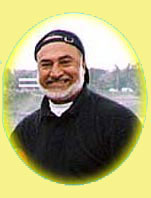
Another sport in which Sikhs have excelled is Volleyball, whether it is the traditional or inter-national style, names like Teja Singh, Mehar Singh, Kirpal Singh, and Raghbir Singh Rahi, stand out in the Volleyball greats. There is hardly a trophy in Kenya that has not been won by the Sikhs.
In Tennis, Sikhs have never risen to great heights, but have played this game more as a recreation. On the local courts one would still meet veterans like Mahan Singh, Naginder Singh, Rur Singh, Amar Singh Kang, but there seems to be apathy amongst youngsters to take to this great sport. Same story exists as far Football is concerned, years back Sikhs had outstanding players like Surjeet Singh, Mehar Singh and Nirmal Singh, who all gained representative - but lately there is hardly a Sikh to be seen playing this sport, which rated as one of the most popular sports in Kenya.
In the lesser known games like Billiards, snooker, badminton and Table Tennis, the Sikhs have yet to make a tangible break-through even though in Table Tennis in Jarnail Singh, the com-munity has an outstanding player.
Another Sport in which the- community needs stirring-up is Athletics, in which three in the old days -put -up creditable performances, these being Dr. Balwant Singh, late Ujagger Singh Rai and Daljeet Singh.
In three of the most expensive sports, which over the years have been meant for a privileged class Sikhs upon joining recently have not only made instant impact, but- gained immediate success. In Golf, Gursaran Singh "Channi" has astonished the Golf pundits with his meteoric rise in a space of eighteen months, he is on handicap 7 the lowest held by -an Asian in East Africa, but his success in Golf has been a loss to Cricket Others who have taken to this sport and are doing well are Harbans Singh, G. S. Sandhu, Harbhajan Singh Kalsi, Swaraj Singh, Harbhajan Singh (Nyeri).
AN EXCLUSIVE SPORTSMAN : MR. HARBANS SINGH, O.B.E.
The Sikh community is indeed proud of Mr. Harbans Singh who is a beacon of light and a. tremendous example to younger sportsmen for which the Sikhs are well-known here and internationally.
Mr. Harbans Singh has been the President of Sikh Union, Kenya Cricket Association and the Asian Sports Association.
In 1962 he was honoured with an M.B.E. in the New Year's Honours, "for his devotion to the well-being of sport, more notably cricket and hockey, has been outstanding over many years. His keeness and behaviour as a player has been surpassed by his efficiency as an official and organiser". The success at the Tokyo Olympic owed much to his "personality and unflagging efforts".
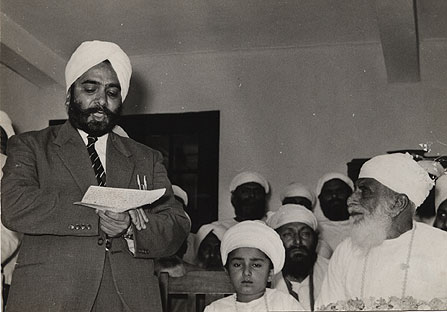
S. Harbans Singh, the President of Sikh Union delivering a welcoming address to Satguru Partap Singh Ji on his visit to East Africa in 1959
He was the Secretary of the East African Cricket Conference. In 1963 he was Kenya's
Official Representative to the National Olympic Committee at Badan Badan in Germany.
1964: Mr. Harbans Singh was Chef de Mission to the entire Olympic Contingent for Kenya to Japan.
1965: He was again Kenya's Representative at the International Sports Committee Meetings held in Rome and Madrid.
1966: He is still keeping up the good old "activity" in sports alive by playing Golf at Royal Nairobi Club at Karen. He is the only non-European Honorary Member of the Kenya Kongonis Cricket Club. He is very active also at his desk at the Barclays Bank (Government Road) where his enormous responsibilities as the Assistant Manager keep him exceedingly busy.
This article appeared in a magazine in 1966 and is a tribute to the late S. Harbans Singh Sehmi.
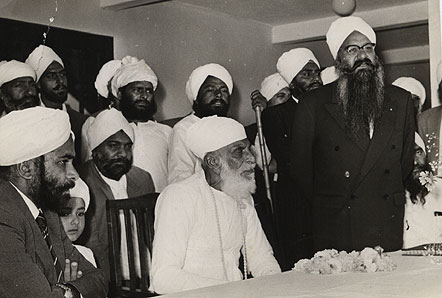
S. Kirpal Singh Sagoo welcoming Satguru Partap Singh Ji at the Sikh Union Club in 1959. S. Harbans Singh is on extreme left and behind S.Kirpal Singh Sagoo stands Hon.S. Mota Singh now retired Judge.
Social & Cultural Events at S.U.

The FIRST High Commissioner of India to Kenya Hon. Apa Pant. He was so popular that the India Office was called Apa pant Office even after his departure from Kenya.
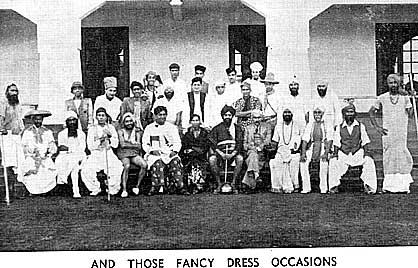

------------------------------------------------------------------------------
WRESTLING IN EAST AFRICA
In the art of wrestling, the name of Thuman Singh will be forever etched in the history of East Africa,where he remained a champion for a number of years. He was followed by his brother Swaran Singh as champion. They had their own hotel on River Road normally called 'Bhalwan da Hotel'.
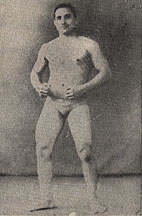 Thuman
Singh , Champion wrstler of East Africa
Thuman
Singh , Champion wrstler of East Africa
Swaran
Singh, younger brother of Thuman Singh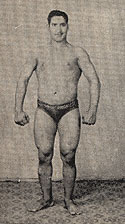
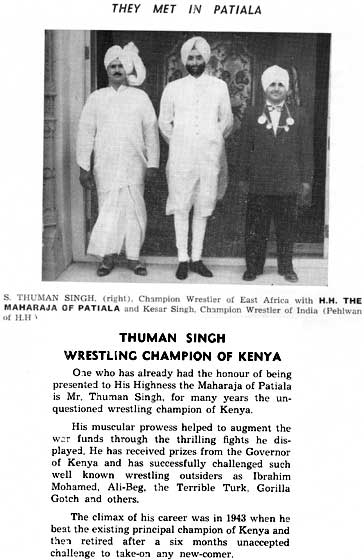
During World War 2, the armed forces were regularly coming over to the areas populated by Asians to look for prostitutes. The following excerpt from 'A Regal Romance' by Ameer Janmohammed shows how the Asians defended themselves-spearheaded by Thuman Singh.(Kanwal)
"The only "hostilities" that I recall in Nairobi were between members of the armed forces passing through Nairobi and the local population. Some of the allied troops, especially the South African soldiers, all white, had disdain for the Asian and African populations of Nairobi, and appeared to think that all dusky women were fair game. The Military Police tried to maintain some semblance of control, but soldiers seemed to have unbridled licence to behaved pretty much as they wanted to. After patriotically putting up with abuse for some time, and after seeing their numerous representations to the civil authorities being ignored, the Asian community of River Road in Nairobi (many of whom lived above or near their shops) decided to take matters in their own hands and formed vigilante patrols to protect their women and children from the soldiers. If memory serves, an important member of the organisation was a Mr. Thuman Singh, a sweetmeat (mithai) seller, who was also a champion professional wrestler.
Over a period of time, clashes took place regularly when soldiers ventured into River Road, and the locals armed with hockey sticks usually came out on top. Several marauding and usually inebriated soldiers were beaten up on River Road. Eventually the authorities thought it prudent to accede to the request of the Asian shopkeepers. River Road was declared out of bounds to all WD personnel. There was little point in soldiers acquiring broken bones without having yet encountered a single German, Italian or Japanese."
-------------------------------------------------------------------
HORSE RACING
In the kingly sport of Horse Racing, two Sikhs have been owners and have enjoyed great success, U. S. Dhariwal who is now in India, enjoyed tremendous success with "Jerabub" (below) winning most of the main races in Kenya. Recently, Mohinder Singh Kambo has also met reasonable success with his "Punjab" and Ranjeet" and he is a very popular personality on the Ngong Course.
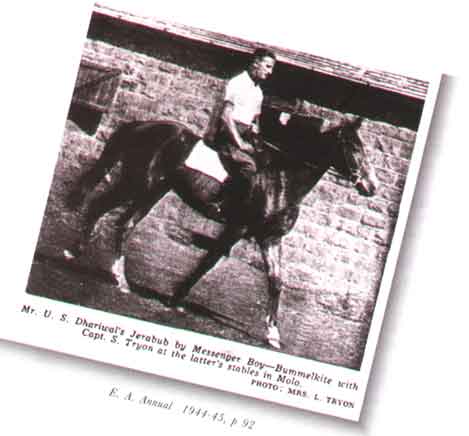
'Jerabub' was bought by Mr. Ujagar Singh Dhariwal for a record price of £475 in 1944. Jerabub won both the classics, East African Derby 1945 and the Kenya St. Leger 1945. Besides the classics he won principal races, which included the Kenya Gold Cup. The following picture is of Jerabub being led in by Mr. U.S.Dhariwal after winning the Kenya Gold Cup.
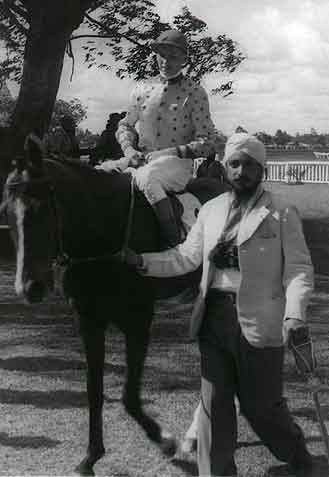
On 2nd January 1946 Jerabub was shipped to Bombay where he ran 5 times. He won the Aga Khan Cup & The Brabourne Cup, and was placed second twice and unplaced once. Clearly a remarkable horse of a remarkable Sikh owner, who in those times had the tenacity to own such a horse, as the period of Colonialism and racism was at its peak in East Africa at the time. Besides Jerabub Mr. Dhariwal owned other horses Panoi, True Blue, Triand and Cry Havoc. He was the leading (First Sikh) book maker (Turf Accountant) in Kenya and was a keen sportsman who got the Hockey Stadium built at City Park. He organised sports days at the Sikh Union Club, which included motor cycle grass racing and athletics.
The above information has been sent by his illustrious son Harbhajan Singh Dhariwal (below), who was the first Asian to form the ethnic Lion Club in the whole of United Kingdom in 1970.
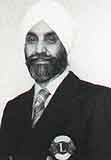
Harbhajan Singh Dhariwal, or rather Lion H.S.Dhariwal, although born in India, grew up and studied in Kenya under the guidance of his talented father. He came to United Kingdom in 1965 and had the honour to be elected the first Lion District Governor of the England Counties. He has numerous 'Help Appeal' projects to his name. He was nominated for the post of Internation Director of Lions from 1986-88. A Singh or a true 'Lion' whose achievements have made us feel very proud.(kanwal)
Lastly is a sport in which one Sikh has brought unfound glory to the community is Motor Sport. Joginder Singh and Jaswant Singh the two brothers won the 1965 East Africa Safari in great style and were feted all over the country, not satisfied with this success Joginder went on to win the 1965 E.A. Motor Rally Championship, winning the Uganda 1000, and the Tanzania 1000.
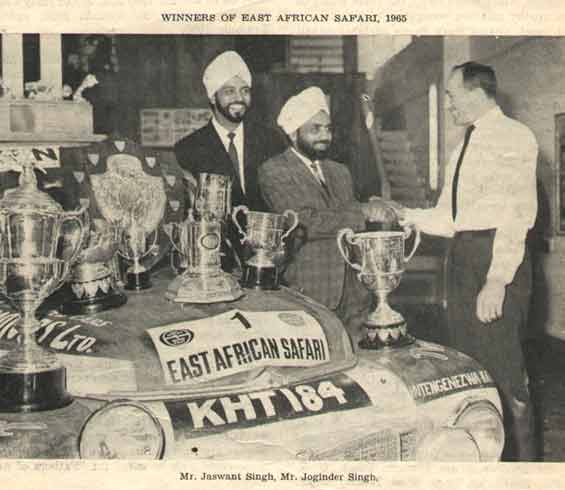
He participated in the Mount Carlo Rally in Sweden, finished 36th overall out of 41 finishers - a most remarkable performance considering the absolute contrast in conditions compared to the E.A. Safari.
In grass track, which has been recently revived, Sikhs used to have brilliant riders in Harbans Singh (Bansi) and Niranjan Singh. Now Kishen Singh, Sucha Singh and Didi are beginning to come into lime-light
THE SAGOO SPECIAL
As far as the Sikhs go, Gurbux Singh Sagoo, was the pioneer of Sikh racing drivers in Kenya. Just as Joginder Singh brought joy to rallying fans all over Kenya, it was Gurbux Singh Sagoo who brought glory to the Sikhs on the racing track in the golden era of motor-sports in the sixties.
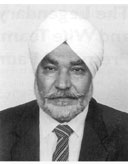
Kugi sagoo
Gurbux Singh Sagoo, also popularly known as "Gearbox" and Kugi to many of his fans was not only skilled as a racing driver, but an engineer "Par Excellence". He developed his own two racing machines modelled on the Formula One racing cars, which were known as "Sagoo Mark I" and "Sagoo Mark II". Kugi was greatly supported in preparation of the Formula One model racing machine by his brothers Parminder Singh Sagoo,Tarlochan Singh Sagoo and cousin Harbhajan Singh Bhamra so famed as the tallest Sikhs of the nation. Kugi was the son of Thakker Singh who settled in the country in the early 1900s.
With those two machines he virtually dominated the Nakuru racing track from 1964 to 1968 and the Nairobi Embakasi track in the late sixties, winning the East African Track Racing Championship for four consecutive years. His duels with Pat Neylan on the Nakuru race track had become part of folklore amongst racing fans in Kenya.
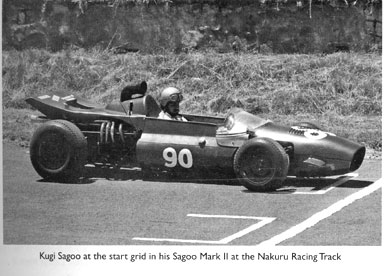
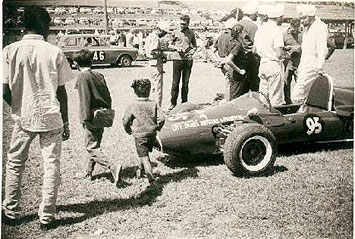 Gurbux at the Nakuru race track (top & below)
Gurbux at the Nakuru race track (top & below)
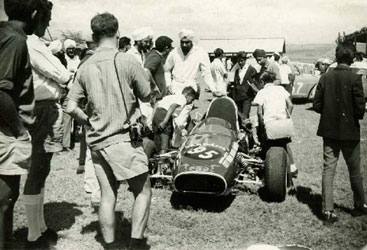
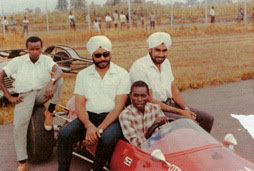
Brothers Kugi & Pindri at the races
Gurbux retired from motor-sports at the end of the sixties, but even now in the sunset years he still runs one of the most accomplished motor workshop in Kenya called "CITY PANEL BEATERS & PAINTERS LTD", which has been in existence for nearly half a century!
A profile by Papu Grewal (from SU souvenir 2008)
SARDAR HARBANS SINGH MATHARU
Mistry Maghar Singh Matharu (founder President of East African Ramgarhia Board) was a keen collecter of antique items and amongst his collection were many famous names of motor cycles of the day, such as Baby Triumph, Aerial, Douglas and Norton etc'. The love of motor sports and grand fatherfe collection inspired the young Harbans Singh to become a self made expert in the field of motor cycle arena.
The well known Sikh Union Sports Club in Kenya was in the fore front of adequate sports facilities and quickly realised the popularity of the motorsports, the management organized motor cycle track races. It was here that S Harbans Singh Matharu excelled as an excellent motor cycle rider and won many races including the Sikh Union Cup a coveted trophy. His popularity grew when a large following of Sikh enthusiasts came to him for training and advice. His love for the sport was so great, that he imported two J.A.P. 300cc & 500cc engines from England to participate in the superseded Speedway racing.
Sardar Harbans Singh was born on 11th November 1918 and now leads a retired life in Kent, England. He has two sons and a daughter living the USA.
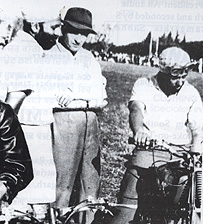
Harbans (Bansi) is seen lined up for a major race at the Sikh Union Club. Looking on admiringly is Gurcharan Singh (Guru), the well known cricketer and leading organiser of the track event and owner of The Photo Studio.
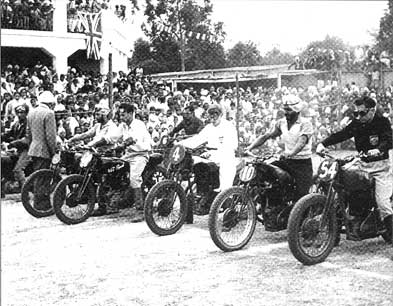
Motor cycle racing at the Sikh Union Club
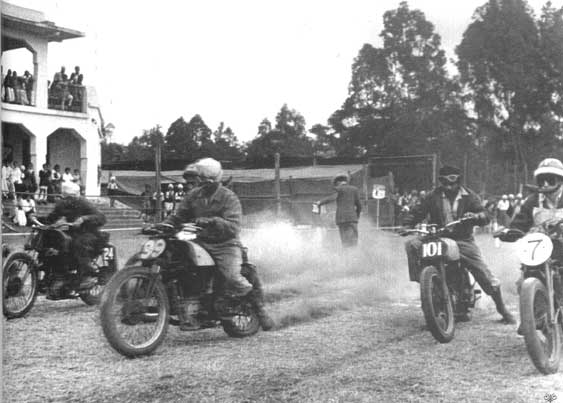
Motor Cycle racing at the Sikh Union Club was a great event where people like-Harbans Singh, Piara SIngh Bhari, Niranjan Singh 'nanja', Pal Singh, Hari Singh, Harjodh Singh, Tara Singh, Vic Preston, Collins, Jack Simonian, Mohd. Hassan, Mohd. Shaffi etc. participated.
ADMINISTRATION
The success of sports to a great deal depend upon sincere and dedicated persons who spend a great deal of their spare time in honorary capacity, and to them goes the credit for the immense strides Kenya has made over the years in the field of sport. The Sikh community are fortunate to have amongst them a small band of highly capable sports administrators.
The reins of many a national sports organisation in Kenya has been held by a Sikh sometime or the other. Two who can be singled out in this respect are Harbans Singh and Mahan Singh, and these could both be called the "Fathers of Association.
Mahan
Singh was one of the founder of the Kenya Hockey Union and during its infant years
a most considerate and careful father. He was president of the Union for two years.
He was also a backbone of the Asian Sports Association
for many years and
also its president for some years. He was also Chairman of the East African Hockey
Union.
Sukhdev Singh, a very hard-working Secretary of Kenya Hockey Union for nearly six years, has recently been elected Chairman of the East African Hockey Union, and was also the first President of the Kenya Volleyball Association. His successor in Volleyball has been no one else but Mr. K. S. Bawa who has emerged on the Sports Arena recently with a tremendous impact. Bawa is also Vice-President of the Nairobi Hockey Association and also on the executive of the Kenya Table Tennis Association and Kenya Badminton Association.
Hardial Singh for many years has been Match Secretary of the Kenya Hockey Union, is now its General-Secretary. He is also President of the Kenya Umpires Association and a International Class Umpire
Harcharan Singh Mangat was chairman of the Selection Committee of the Olympic Hockey and is now Senior Vice-President of the Kenya Hockey Union.
Kenya Olympic Association is the umbrella sports body in Kenya as far as Olympic and Commonwealth Games are concerned and its 'General Secretary is Gursaran Singh Sehmi.
Kenya National Football League, one of
the most powerful football bodies in Kenya has one
of its founders and patron
a Sikh who is also president of the Junior Football League.
Sikhs have played a very big part in the deve-lopment of sports in Kenya and it was no surprise that the honour of Chef-d-Mission for the year 1964 Tokyo Olympics was conferred on the lead-ing Sikh Sports Administrator, Harbans Singh Sehmi and furthermore, it was Harbans Singh who was the first sportsman in this country who was made an O.B.E. for the Services of Sports.
Having said enough, we must see what are our material handicaps, which are twofold - lack of finance and the absence of enough youngsters. We must take a realistic view about the proper development of the youngsters and although progress in the initial stages will be at snail's pace, nevertheless the results gained later would be most helpful indeed. It is also a pity that not enough members of the Community avail themselves the advantages of the first class sports amenities available at the Sikh Union Club, the leading sports institution in Kenya.
GURU NANAK RALLY
courtesy of Jasmer Grewal
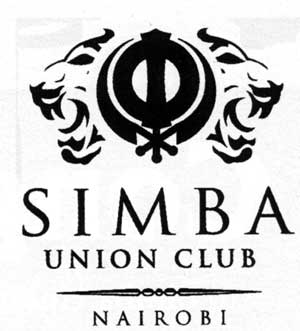
Simba Union is synonymous with sports in Kenya. Having gained prominence in Hockey Cricket, Grass track motor cycle racing, but have continued to play a dominating role in organizing the Guru Nanak Rally.
In 1973 the Guru Nanak Rally came on the scene with a bang, drawing a very Handsome entry of 71, including some of the biggest names in the Rally scene of those days.
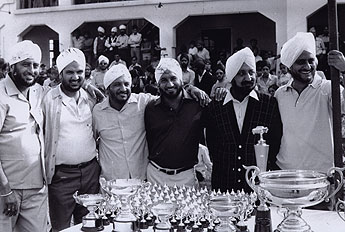
Organisers of first Guru Nanak Rally - (Hardial Singh, Meharban Singh, Inderjit Singh, Mehnga Singh, Mohinder Singh & Avtar Singh bassan)
The array of trophies was something to be seen to be believed as a generous prize of money. It was won by non other, but one of the top combinations of the period Vic Preston and Bill Parkinson in a Mercedes 250.
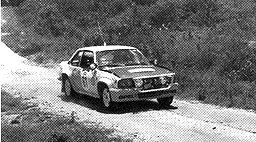
Since the first event Mercedes have taken a back seat and the rally has ever since been dominated by Japanese cars except 1984 when the only ladies crew ever to win the Guru Nnak Rally of Ann Taieth and Sylvia King won in an Opel Ascona.
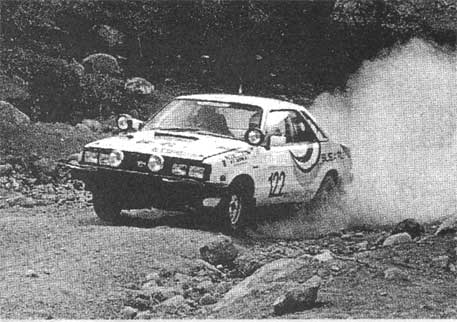
The stature of rally is highlighted by the class of entries received year after year and the list of past winners clearly demonstrates this, when one reads names like Vic Preston Snr, Chris Bates, Ann Taeth, Patrick Njiru, Ian Duncan, Steve Anthony, Sarbi Rai, Rob Hellier, Tanveer Alam, Katto, Bailey, Cavenagh and many more.
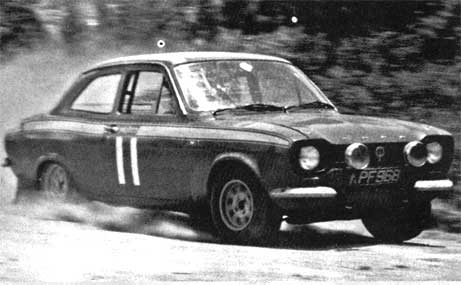
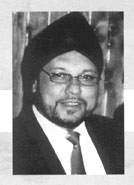 Information supplied by Pali Sehmi (ex-president of SU Club) - Thanks (harjinder)
Information supplied by Pali Sehmi (ex-president of SU Club) - Thanks (harjinder)
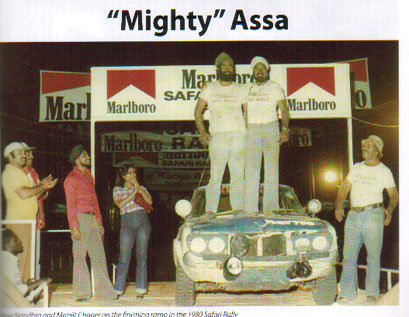
1980 safari rally Assa Nandhra & Manjit Chaggar
MORE Sports .....................
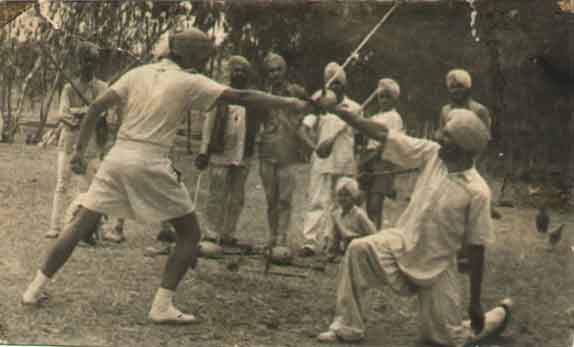
Sikhs in Nairobi displaying their skills in the traditional Martial Arts 'Gatka' during 1950's
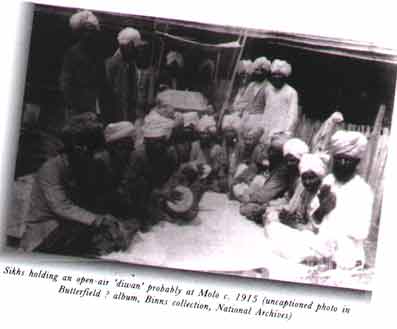
GAMES OF CHESS
From The Gate Hangs Well by James Stapleton (pp 105-107)
Ram Singh, the Sikh
who ran the saw-mill on the other side of the main road [near Timboroa ]was traditional
in appearance. He wore a bright turban with his hair in a bun underneath and he
cultivated a massive beard. He looked down with undisguised scorn on all the other
peoples and religions of his homeland, dismissing the Buddhists [sic] and Moslems
with a sneer that bloated his cheeks and puffed his beard. Of the European and
his culture he was openly envious; he drank whiskey as other men drink tea.
The first time I met Singh I had a puncture on the main road right by the turn
off to his mill. 'You are the new farmer in the district isn't it?' He asked as
he pulled me up from the wheel-jack 'My driver will mend the wheel' He shook my
hand vigorously and was still shaking it when the driver announced that the wheel
was changed. 'You must come and have a little drink with me one evening', he said
when I thanked him. 'And bring your wife.'
'And if you're passing our place
do call in any time.
He was round at our house the next afternoon, and talked
and shook hands with Elizabeth until I got in from the farm.
Elizabeth prepared
tea and Singh drank his in the form of a cup of sweet milk with ten minims of
tea added.
'You play chess. No?' he said pointing at the board under our book-shelf.
With due modesty I admitted I played a little.
'You must come to my house
and play the chess.'
After that the Sikh often came round to play chess mostly
in the afternoons though. The first evening session at his house was the last.
Elizabeth didn't go and I said I'd be back early.
The sawmill had originally
belonged to a European. The house was European designed and the furniture was
also of the West, but the atmosphere was pure Indian. It wasn't so much what I
could see - in fact, until my eyes became accustomed to the gloom, I saw hardly
anything at all - it was the indescribable atmosphere of the East that immediately
hit me.
When my eyes became accustomed to the gloom, I could see that, except
for two easy chairs, a settee and two small tables, the large room was practically
bare. The dark cedar-wood walls were decorated with a few cheap prints of squatting
idols or saints, and there was some Indian-made brassware on the mantelpiece;
otherwise there was nothing oriental in the room. Even the unopened bottle on
one of the small tables originated in Scotland. Yet I might well have been in
Bombay.
Right beside the bottle were two glasses and a chess-board: Ram Singh
obviously
meant business. I soon learned that he was a fast pourer of drinks
and a fast, cunning chess-player. We played chess, drank whiskey, ate curry, drank
whiskey, played chess and drank whiskey in that order - I think.
When I awoke
next morning there were thousands of children racing through the room, in one
door and out of another, while my temples throbbed as though they were running
over my head. Then they finally noticed the stranger in the camp and crowded around
to see the phenomenon, chattering shrilly and pointing at me every time I peeped
from beneath the blankets. At first, before I recollected where I was, I thought
that by some curious chance I'd got into a preparatory school for Indian children.
But in truth they all belonged to Ram Singh and his mill manager, and were startling
testimony to the success of the Purdah.
After a cup of sweet condensed milk
laced with a dash of tea, I carefully made my way to the car without having laid
eyes on the ladies of the establishment. Ram Singh, as bright as if he'd just
returned from a holiday at the coast, went through an extra hearty handshaking
performance that stirred and shook the devils in my head to even greater activity.
'Come again, anytime you like', he said. 'The chess makes the good friends, isn't
it?'
I got to know Ram Singh very well. We became firm friends and often
met for a game until his mill was burnt out and he left the district for good.
But our worlds were poles apart. Conversation was always difficult between an
ignorant European who couldn't speak Indian, and an Indian who could speak English
but who finished his every sentence with 'isn't it', so that one never knew if
it was a statement or a question.
So even with Indians introduced, the world
was still a lonely place.
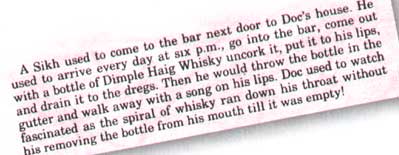
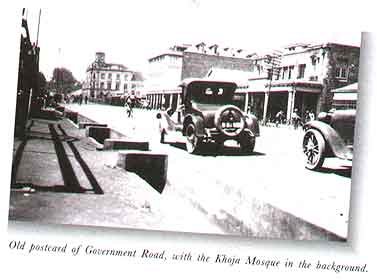
SIKHS who laid their lives for the land of their adoption
MR.
JASWANT SINGH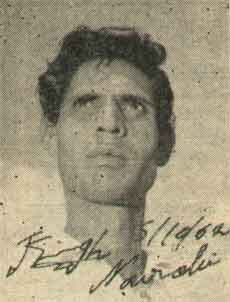
Mr.
Jaswant Singh Bharaj was born at Lakhpur in the Punjab in 1935 and while a child,
first came to Kenya in 1940. His father had come to
Kenya in 1914 and worked
for the Uganda Railway. Jaswant Singh left for India for education in 1947 and
returned to Kenya in 1953.
Mr. Jaswant Singh had a special interest in the history of India, which led him to study the history of British domination in India since 1857. He also came across the history of Revolutionary Party of India, which believed in achieving free-dom by violence. The incident of Jallianwala Bagh at Amritsar, and the inhuman atrocities of the British Forces against the common man made him resent the British in general.
Later, Mr. Jaswant Singh, on returning from India on 29th December 1953, was forced to join the Kenya Police Reserve. During his training he and his colleagues were badly and insultingly treated. Once he was struck on the crown of his head. This left a deep scar on his mind and turned him into an anti-British revolutionary.
This made him a sympathiser of the anti-White section among the Mau Mau and he com-menced manufacturing and supplying them guns, ammunition and other material. He supplied piping to the Mau Mau Bush Fighters for making guns and taught to a few of them the art of gun-making.
He was arrested in May, 1954, tried and sen-tenced to be hanged In the appeal, the sen-tence was reduced to life imprisonment but he was released in 1958 after serving four and a half years in Takwa Detention Camp, off Mombasa, along with the other detainees such as Messrs. John Mbiyu Koinange, Mr. Achieng. Oneko and Mr. M.: C. Chokwe.
He was a sincere and selfless
supporter of the African struggle for freedom and served Africa and the African
in every way possible. By profession he was a Carpenter, Mason, Plumber,
Electrician,
builder, Radio and Motor Mechanic, Welder, Lorry Driver, Tractor Driver and Gun-maker.
MAKHAN
SINGH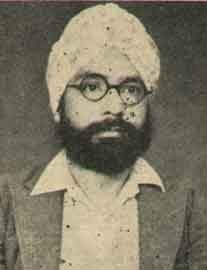
Born in27th
December 1913 in the village of Gharjakh, District Gujranwala (now in Pakistan).
Makhan Singh spent his early life in utter poverty and in very difficult circumstances.
He had a generous heart and a very strong will -power and applied all his energy
in tackling what-ever problem he was is confronted with.
He first came to
Nairobi in April, 1927 and passed his London Matric in 1931. He joined
His
father's Printing Business and also started taking interest in the Labour Trade
Union
movements. In 1937 he founded Labour Trade Union and became its first
Hon. Secretary.
In December 1939 he went to India, served an imprisonment
for about two and a half years
Due to his Political activities and was completely
released in 1944 after serving a further restriction in his own village.
He returned to Kenya on 20th August, 1947, of his time re-organising the Union Congress.
Trade Unionism was not the only activity in which Makhan Singh took such a keen interest; he was also one of the spear-heads in attempting to relieve Kenya from the yoke of Colonialism and advance it towards full freedom. On April 23rd, 1950, in his impassioned speech at the Kaloleni Hall, he had urged that the time had come for the people to unite and to demand in single voice that the country was theirs and that no foreign power had the right to rule over it. He set the ball rolling for eventual independence.
Makhan Singh was arrested on 15th May 1950, charged for various offences and acquitted, and was eventually restricted by the Governor under the' Deportation (Immigration British Subjects) Act for an indefinite period in remote and isolated areas. He was restricted at Lokitaung for about 'three years, then transferred to Maralal for eight years and later to Dol Dol. He underwent a hunger strike for twenty-one days, drinking plain water only, in protest against not releasing Jomo Kenyatta and others.
Makhan Singh spent the best part of his life in prison or restriction in the service for the African cause.
UNADULTERATED IDEALIST
From interviews with Fitz De Souza, Nairobi
Makhan Singh was very well known
as a pioneer trade unionist in Kenya and altogether a remarkable person. He was
a man of principles, and nothing, no concern for himself would sway him from his
stand.
His father Sudh Singh had come here in the early years and Makhan
Singh was born here. He schooled in India, however, and then returned here in
1943/44.While in India he had openly joined the Communist Party there. The colonial
government here had no intention of letting him back into this country but he
managed to slip out of the ship and get up to Nairobi. He immediately started
organising the trade union movement, with Fred Kubai. In 1947 he was arrested.
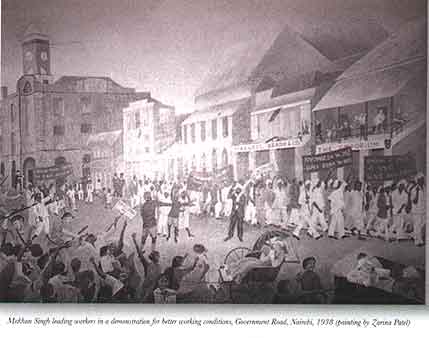
Makhan
Singh had been in detention for seven years when I returned from my studies in
England in 1952. It was through my job with the legal firm of 'Madan & Shah
that I first came into contact with Makhan Singh, through his father. Sudh Singh
was very worried about his son and in his attempts to get him released the old
man used to come to visit Madan in the office a lot. As Madan was often very busy,
he'd send the old man in to talk with me.
Sudh Singh was an old man, about
70, I would say. He was a big, solid man with a long white beard. He owned and
operated the Punjab Printing Press in a tiny shop, only about 10' x 20', behind
River Road. It was the only press in Kenya that could print the Sikh's special
Gurumukhi script and I remember the old man bending over and setting his type
with great care. He had a couple of young Sikhs there to help him, but he did
most of the work himself. He used to do wedding invitations and other such printing
work for the Sikh community, and I think he briefly published a Sikh newspaper,
written in Gurumukhi.
In an effort to get Makhan Singh released, Madan and
I had been to see the Governor about some documents, and had got his agreement
to release Makhan Singh if he apologised for his more radical policies. This I
thought Makhan would do, for basically he was a man of law and order, against
the use of violence. So at the old man's request I drafted a Petition addressed
to the Governor in the father's name. In it we pleaded for leniency, saying, 'Please
have sympathy for my son who is a very decent, though perhaps a little misguided,
person.
I was very proud of the way I had worded the Petition for the old
man and I made the mistake of sending a copy to Makhan Singh. He immediately sent
me a telegram stating unequivocally: 'Not misguided. Will not he released under
those conditions.'
I was sorry that my carefully worded Petition had been
so unappreciated but I had to admire Makhan Singh for sticking to his principles.
Because he refused to compromise his stand he was kept in detention (in Maralal)
for several years more.
I visited Makhan Singh in Maralal and
we became good friends. After he was released from detention I saw more of him
and then we became great friends. He was a wonderful human being, a very, very
affectionate person. He was totally dedicated to fighting for the upliftment of
people, and a great nationalist, fighting (at least in principle) for the rights
of people not just in Kenya but everywhere. And, although he was an avowed Communist,
he wasn't at all dogmatic.
When Sudh Singh died (in the 1950s) Makhan Singb
invited me to their home on Park Road. I found a whole group of people sitting
on the floor and performing the ceremony that the Sikhs do after the head of a
family has died. Another member of the family brought out a turban and presented
it to Makhan Singh; that is their way of showing that after the death of the father
his authority is passed to the eldest son. I was pleased to see that Makhan Singh
was respectful of Sikh tradition, for he had always insisted that he was an atheist
and had no use for such things.
I can give you another example of what a principled
person Makhan Singh was. I tried to get him into politics but he wanted to continue
with the trade union movement. However, he was given a relatively unimportant
job and then the trade union movement chucked him out completely as they found
his avowed Communist links an embar-rassment when requesting funds from the West.
Makhan Singh was too idealistic.
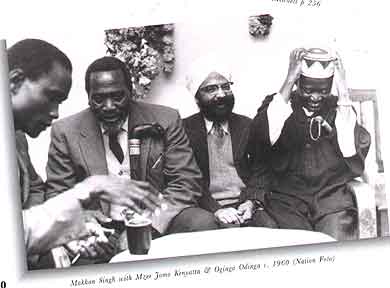
Jomo Kenyatta used to ask after him. One day I invited Makhan Siugh to lunch with
me at Parliament. I had been trying to persuade him to make an effort to get a
job where be could contribute to the development of the country. While we were
talking, Jomo (it was only later that we all began calling him Mzee) passed our
table and stopped and embraced Makhan Singh before moving on to another table.
I was very friendly with Jomo at that time I used to write most of his speeches
so I thought this would be an opportune moment to get Makhan Singh back into action.
I asked him what he would be willing to do. He said, anything worthwhile. But
I don't want you to ask anyone on my behalf for a job. Never in my life have I
asked for anything, begged for anything.' I told him that you were never given'
a job in this world, that you had to fight to get it, and I told him that I was
going to ask Jomo on his behalf. I stood up to go over to Jomo and Makhan Singh
grabbed me by the arm and pulled me down. He was really angry and said, 'I'll
never accept any job that's been asked for, any offer that is not a spontaneous
recognition of my usefulness.'
I was quite staggered by his vehemence, and
of course made no further move towards Jomo, or to helping Makhan Singh get any
job. It wasn't that he was arrogant, for he wasn't arrogant at all. He just felt
that if people didn't appreciate what he had done, what he had to offer, he didn't
want to work with them. He never did get a job. He died a few years later. He
was a total, unadulterated idealist. He wouldn't compromise on anything.
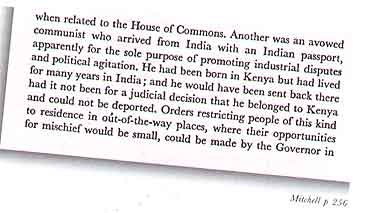
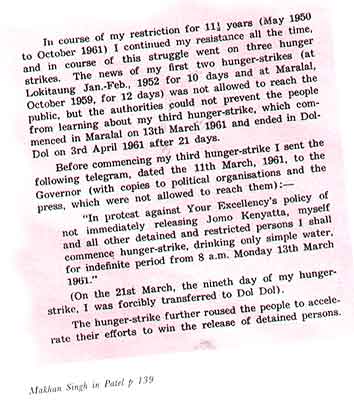
OUT OF AFRICA
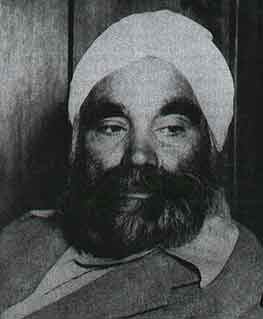
Kehar Singh Dhillon - a pioneer of sheer courage.
Kehar Singh Dhillon was one of thousands of Indians who emigrated to Colonial Africa during the early 20th century to work for the British railroad industry. With dreams of building a life and family in a new society he became embroiled in a rags-to-riches saga of passion, struggle, tribal politics and murder. Almost a century later Pally Dhillon, tells the story of his courageous grandfather, who left a powerful mark behind. Pally in his novel "Kijabe - An African Historical Saga" narrates his grandfather's adventures in Africa. Although he has changed the names of the characters but historically he has kept to the truth. A book -a 'must' for all 'Africans'.
The following photographs have been taken with the courtesy of Pally Dhillon from his web site: www.Kijabe.com., which the reader can access for more information.
'KIJABE' has been translated into Punjabi for the benefit of Punjabi readers. Another excellent work. It is known by the new name "SURKH HANERI"
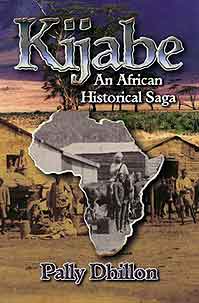
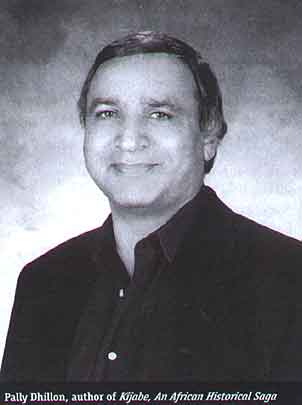
About the Author
Kenyan born, Pally Dhillon lives in Naples, fl. A keen Technologist and a sports enthusiast he was the president of the field hockey association on the West Coast, as well as being a player, coach and organizer. The organizer of the medal ceremonies and announcements for hockey at the 1976 Montreal Games and the 1984 Olympics, he has traveled all over the world to play hockey and golf. Walk with Pride is his third novel.
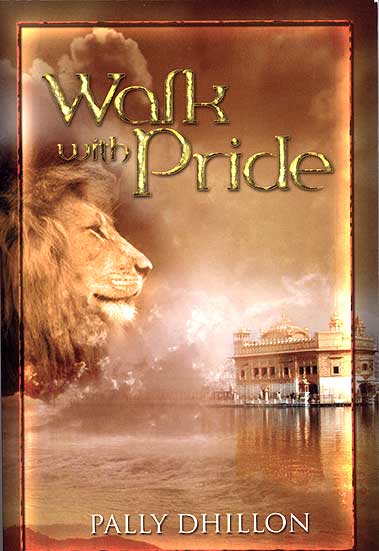
Three Indian Pioneers Face Genocide and Changing World in a Stunning Historical Novel
Walk with Pride by Pally Dhillon is both a shattering love story and a gripping exploration of betrayal, wealth, terrorism and war
NAPLES, Fla. (distribution date) –Walk With Pride by Pally Dhillon is a moving epic about a trio of Indian friends who immigrate to three different East African countries in the early 20th century.
Three childhood Indian companions and their families find themselves caught in the turmoil of history in the page-turning novel Walk with Pride, by Dhillon. From the Mau Mau Freedom movement in Kenya to the brutal warfare between the Sikhs and Hindus, Walk with Pride examines the unthinkable turmoil of lives in flux.
Written in gorgeous, evocative prose, Walk with Pride is both a brilliant character study as well as an unforgettable expose of the trauma of genocide. A rich generational love story, Walk with Pride examines the ties that bind even as it builds to a shattering conclusion that will linger in reader’s memories.
Suspenseful, thrilling, and deeply moving, Walk with Pride exposes how the unhappy events of history may repeat themselves, but the human spirit always conquers adversity.
For more information or to request a free review copy, members of the press can contact the author at pdhillon@arthrex.com. Walk with Pride is available for sale online at Amazon.com, BookSurge.com, and through additional wholesale and retail channels worldwide.
AN EXCELLENT BOOK WRITTEN WITH CONVICTION AND RESEARCH - A VERY INTERESTING & ABSORBING NOVEL INTERMINGLED WITH FACT & FICTION. A MUST FOR ALL BOOK CONNOISSEURS. (Kanwal)
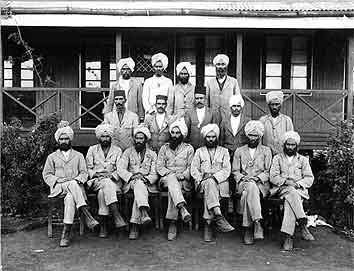
Sikh pioneers in Kenya - photo taken in 1914
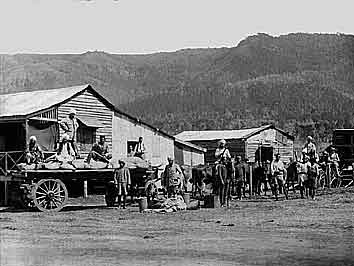
Sikh Traders in Masailand - during 1920's
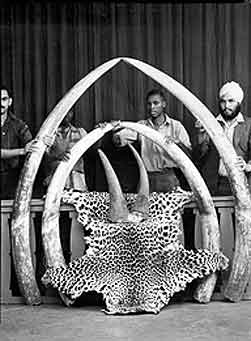
Tarlok Singh the hunter with his tusks 1952
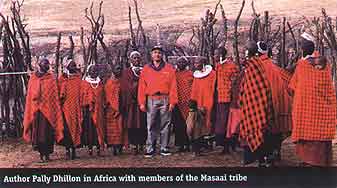
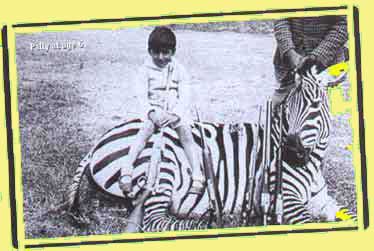
Pally at age 6 atop a zebra
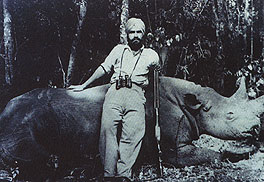
Serving in the East African Meterological Service, Gurcharan Singh Rana was also a keen hunter. Here he is seen with a prized Rhino during the 1940's

The King
PUNJABI HERITAGE IN EAST AFRICA
The history of the South Asians in East Africa is not very old. It is only about 100 years since the first Indians landed on the shores of Kenya, namely Mombasa. The journeys in those days were accomplished in dhows which were the main source of transport and starting from Bombay the journeys could take as much as months to complete as the dhows depended on the state of the winds. It was after a lot of hardships that some of our ancestors reached Kenya to serve in the Uganda Railways which was being built from Mombasa to Kampala.
The Punjabis (Hindus, Muslims & Sikhs) were the main source of skilled and semi skilled labourers who worked on the railways. They suffered numerous hardships including the lions of Tsavo.
Do You or Your parents or Grandparents had any escapades, adventures, memorable incidents, interesting stories, their rise to fame or riches, old photographs or mementoes, souvenirs, brochures of Kenya, Uganda, Tanganyika - magazines printed by gurdwaras or federations, clubs, schools, students etc. Any documents or photos about East Africa – anything!
I am in the process of writing a book on the ‘Punjabi Heritage in East Africa’ and I need information as much as possible. Just get in touch with me and send me the information (which will be returned after use). Your name will be acknowledged in the book.
Your assistance would help in inserting your ancestors’ names in the history of East Africa.
Kindly contact,
Harjinder Singh Kanwal,
20 Trewint Close,
Exhall,
Coventry CV7 9FG
U.K.
Phone: 024 7631 9483
E/mail: harjinder@kanwal99.freeserve.co.uk